




by Maya McFadden
Teachers, parents, and students gathered at Brennan-Rogers School Thursday to say a final bittersweet farewell to a school that the city’s public school district has decided to close and that school “family” members described as a safe, calming, community-oriented space that will be missed.
During the event, the Brennan-Rogers team filled shelves with clothing, board games, and books for families to take for free so that the like-new items weren’t left behind. Book bags filled with school supplies and food from Lucky’s Star Bus Cafe were also available to help the community celebrate the school that was.
Ex-Brennan-Rogers educators like Charlene Neal-Palmer gave long hugs to dozens of former students at Thursday’s gathering at the now-closed K 8 school in the West Rock neighborhood.
Neal-Palmer was one of more than 50 Brennan-Rogers “family members” who joined an official send-off for the school community, which they weren’t given before the district followed through with the superintendent’s recommendation to shutter the school to help close a budget deficit and avoid district-wide teacher layoffs. Brennan-Rogers Principal Kimberly Daniley arranged the two-hour gathering for educators and families to say their good-byes and learn where they will all be displaced to next school year.
“We didn’t get a chance at the end of year to have a sense of closure,” Daniley said. “So we’re here to send everyone off with love.”
While several educators and students knew their placements Thursday, Daniley said she hasn’t yet been informed of her assignment for the new school year.
Neal-Palmer is next headed to Davis Street School, which she taught at for seven years before transferring to Brennan-Rogers four years ago. She hopes the transition which she described as “going home” will be smooth. She said the transfer process had a quick turnaround soon after the board voted last month to close Brennan-Rogers.
Because several Brennan-Rogers educators noted that the moving process was difficult and even cost some money out of their own pockets, many materials were left behind at the school Thursday.
As educators spotted their students from across the room, they shared hugs and “I love you”’s. Many of the families and educators used Thursday as an opportunity to share where they will be placed for the new academic year in hopes they could ease their nerves by confirming they’d see a familiar face.
While at Thursday’s gathering, Neal-Palmer ran into Michelle Wilson, a mother of two Brennan-Rogers students. Neal-Palmer also taught two of Wilson’s older children years ago when they were at Lincoln-Bassett.
When she told Wilson’s daughters Kasey and Corrine she’d be going to Davis, Corrine told her she would next head to Worthington Hooker. “I’m going to miss you so much,” Corrine told Neal-Palmer. “I hope

there’s good teachers like you there.”
Wilson said attending the Thursday gathering was nice for her girls to say their farewells to friends and staff. She said the district’s special lottery for Brennan-Rogers students was easy. The families were asked to pick their top three school choices from a selection of schools with vacancies. Worthington-Hooker was her top pick for her daughter Corrine.
Before picking out a few books for her daughters to bring home, Wilson said she is sad to see Brennan-Rogers go and for the “community to lose something.”
Neal-Palmer said for a five-day moving process in a 90-degree building, educators were compensated by the district for just three hours of their time. Her payout totaled to about $96, she said. She and other teachers had to move out of their classrooms by Aug. 1 and find the time to do it while supporting the district’s summer programming.
Some staff told the Independent Thursday the district promised to provide the Brennan staff with a moving team to help them vacate the building by Aug. 1. One teacher said they had to pay out of pocket for movers. Another rented a U Haul truck to help clear out their classroom, as well as a storage unit to keep their materials temporarily stored.
Special education teacher Latrice Peterson, who will next head to Davis Street School, said between summer programing, advocacy to keep Brennan-Rogers open, and moving out of the school, it felt as if Brennan-Rogers educators didn’t have much of a summer break.
Brennan-Rogers “volunteer grandparent”
Elizabeth Yarborough will next head to King/Robinson School. She said she’s nervous but grateful she was able to transfer to the same location as the classroom teacher she has supported for the past seven years. She’s worried, however, about the new track she will have to take to get to work now that she no longer can walk or take the bus from Westville Manor. She said now she will have to take the bus to Dixwell

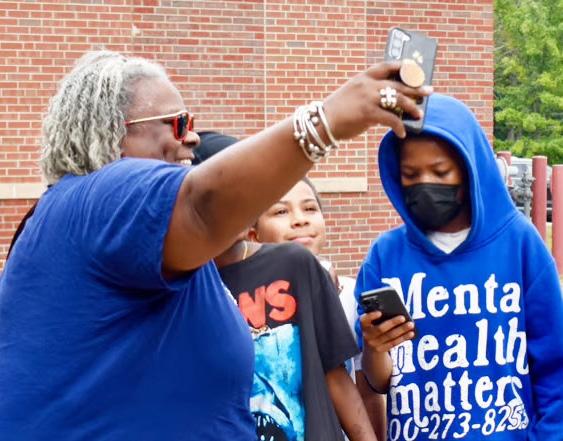
Avenue then walk the rest of the way to the school on the days she can’t catch a ride with a colleague.
Another parent, Jacqueline Mathemy, brought her son General Giles to pick up a crewneck that read “Brennan-Rogers” for a last memory of the school that “calmed him down” and offered one-on-one support for him.
General previously attended Achievement First Elm City College Preparatory Elementary School, where Mathemy said his kindergarten class had 30 students and no personal supports for him. “He would run out of class because of the chaos of 30 kids with not enough help,” she said. She had to spend her time going to the school to sit in class and watch after him.
General said Thursday about Brennan-Rogers, “I like this school. It was fun.”
Mathemy said General made significant improvements when he arrived at Brennan-Rogers for first grade. She said over the past year she didn’t have to sit in his classroom or get daily calls about his behavior. She added that the lottery process wasn’t hard, as she went down to Meadow Street’s school choice office and put in her top three picks for General. She had hoped he would get accepted to BOMUS, where her grandson goes, but instead he was placed at Edgewood School.
Kenicha Lopez, a mom of rising fourth grader Aleana Brown, described every staffer at Brennan-Rogers as family. She made sure to attend Thursday’s gathering to get contacts for Aleana’s friends and teachers to stay in touch. “She’s losing classmates she grew up with. I’m really hoping there will be familiar faces there because she’ll need that,” she said.
Aleana will next attend Mauro-Sheridan School, which was Lopez’s first choice for her. She said she also hopes the school will have a school-based clinic like Brennan-Rogers did to support her daughter’s ADHD needs. “It was so much easier having her medical and school in one place,” she said.
Lopez took dozens of photos of Aleana with friends and teachers to later make her a scrapbook of memories. They also found one Brennan-Rogers teacher that will also be headed to Mauro-Sheridan.
Daniley held a lottery Thursday for students to win Barnes and Nobles gift cards, then also provided the eighth graders with Brennan-Rogers bracelets.
“We love you and congrats to your new schools,” she told each of them. “We hope that there will be something productive for this building that will be a resource for the community.”
Reached for comment Friday, district spokesperson Justin Harmon said he has not heard of any district plans for the Katherine Brennan and Clarence Rogers buildings for next school year.
Neal-Palmer found three students that will head to Davis with her this coming school year. “I’ll bring some comfort to them,” Neal-Palmer said, “and they’ll bring some comfort to me.”
Lucy Gellman
Tanisha Hill soaked in the scene unfolding on Glen Road, where neighbors had replaced the hum and trundle of traffic for the afternoon. Behind her, burgers, fish and just-blackened corn sizzled away on a trio of grills, unaware of a midday drizzle that had started around them. Across the street, neighbors sat down and tucked into sandwiches, slices of watermelon, fresh-baked cookies and banana pudding cups.
Down the block, a handful of kids hopped onto bikes for the first time, and wove in between a series of traffic cones. Hill’s hands hovered for a moment over gallon-sized tubs of blue raspberry, lemon and cherry Italian ice. She smiled to herself. She was, she thought, exactly where she wanted to be—which was home.
Hill, a small business owner who lives on Ellsworth Avenue, was one of dozens to come out for the fourth annual Beaver Hills Block Party, a celebration of community that has continued to grow since its launch in 2021. Organized by Beaver Hills resident (and physicist, author, and self-described science evangelist) Ainissa Ramirez and Ward 29 Alder Brian Wingate, the party brought together the neighborhood’s vibrant multiracial and multigenerational community, with attendees that lingered happily past the 5 p.m. end time.
It marked a joyful return for the event, which took a hiatus last year, and comes on the heels of a Whalley/Edgewood/ Beaver Hills festival in May. In the interest of full transparency, this reporter is also a resident of the neighborhood, and can objectively add that every person interviewed for this article called it some version of a good time.
“Beaver Hills is such a great community, but people don’t interface with each other,” said Ramirez, who moved into the neighborhood in 2005. In 2021, after almost two decades, she still felt like she didn’t know her neighbors. “We wanted to find a fun way for people to interact with each other,” and the block party seemed like a logical answer. “I said, ‘Let’s build something.’”
“In all my years, I have never seen such an engaged and lively collection of neighbors,” she added in an email afterwards. “Personally, my hope is that better and stronger connections have been forged during this festivity … Please know that you’ve made our corner of New Haven shine a bit brighter than the day before.” Sunday, that sparkle seemed to be everywhere, from food pop-ups and an always-bumping DJ booth to craft stations, games of cornhole and giant jenga, shared lunch tables, a chess challenge and Connect Four board from Third Space and a bike clinic that was never not busy. As volunteers from the New Haven Coalition for Active Transportation (NCAT) fitted helmets and seats on one end of the road,
chefs fired up the grills and fried fish and french fries on the other. Between them, there was a show of the diversity that makes the neighborhood so special—and at times, also complicated. Nestled behind Whalley Avenue and Crescent Street on one side and Sherman and Fitch on the other, Beaver Hills is a sort of little universe within New Haven, a blocks-wide radius that includes generations-deep Black and Caribbean American families, a growing Chabad-Lubavicher community, retired peaceniks and old hippies who garden like their lives depend on it (and maybe they do), and young folks who are still just moving in.
It is, in some ways, a more spread out version of Crown Heights, with many of the same historic pain points that a text like Fires In The Mirror seized on three decades ago. Within under a mile, there are distinct histories of diaspora, of trauma, of oppression. There are also neighbors who are effusively nice to each other, and neighbors who hardly exchange a word at all. In New Haven, it’s one of the only racially and socioeconomically diverse holdouts left after years of failed urban renewal and de facto segregation.
Sunday, nobody was interested in teasing out the finer points of that history, because they were too busy saying hello to each other, exchanging addresses and names and the ages of their kids, neighborhood stories, and occasionally cell phone numbers for a play date or hang some time in the future. Hill, who runs an Italian ice cart out of her Ellsworth Avenue home, took in everything around her, eyes sparkling.
“I love it,” she said of living in Beaver Hills, where she moved two years ago after a lifetime bouncing around the Whalley/Edgewood neighborhood. After settling in on Ellsworth, she found her own rhythm, making time to sit out on her porch each Saturday morning so she could greet her Orthodox Jewish neighbors as they walked to synagogue. She loves that about the neighborhood, she said.
“It’s different. You get to experience different cultures,” she said.
That was her hope in opening an Italian ice cart too, she added. As a kid, Hill got excited for any excuse to go to Wooster Square, where she knew she could pick up a confection from Libby’s Italian Pastry Shop. At the time, the neighborhood might as well have been another country; “it would make you feel like you were in Italy,” she said. When she got older, “I wanted everyone to experience Libby’s.”
“It was everything,” she added, pausing the interview to scoop a cup of melty, butter-yellow lemon ice for Jamie Watson and a second of blue raspberry for her son, Tobias. After finding the cart on Facebook Marketplace last week, she decided to pick up Italian ice from Libby’s, so the neighborhood could taste it too.
After getting a call from the party’s or-

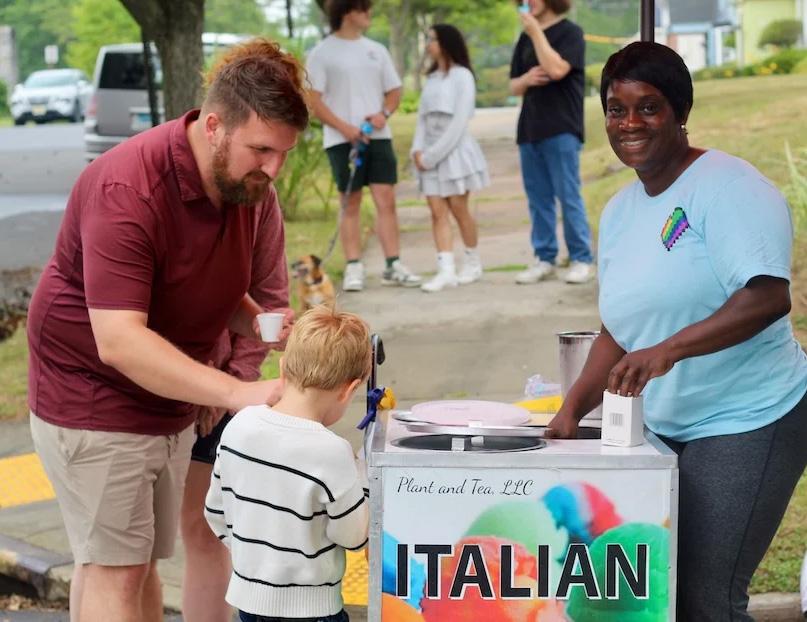

ganizers, Sunday marked her first outing. She was far from the only one making the afternoon feel sweet, indulgent even. Just beyond Ella T. Grasso Boulevard,
street, Mood’s young son Elijah bounced in the bright inflated castle, his Crocs neatly dangling from one of his dad’s hands.
A transplant from New York, Mood moved with his family to Beaver Hills in 2021, in part to escape how loud and overwhelming the city could feel. Despite a house fire that displaced their family last year, the Moods stayed in the neighborhood, moving to a property on Wellington Street that they’ve made their home. When he heard about the block party, he was excited to check it out.
“It’s good! It’s good!” he said. Most days, Mood savors how peaceful Beaver Hills is, particularly the section of streets tucked away between Diamond and Osborn. On days that he drives through the neighborhood on his commute to New York, he often sees neighbors out walking, whether they’re sprinting for the Goffe Street bus or coming home from one of the nearby public schools or out with their dogs.
Sunday, it was nice to learn a little more about who those neighbors are, he said. Between games of cornhole and stops to explore the food options, he and his sons walked down the street hand in hand, greeting neighbors with big, wide smiles. Around them, Glen Road was in full bloom: neighbors fussed over babies, exchanged ebullient and impromptu hugs, went back for seconds on salmon sandwiches and fried fish. Every so often, someone pulled out a cell phone to snap a selfie.
“It feels like family,” said Angie Covington, a lifelong New Havener who moved to Roydon Road from Sherman Avenue almost 12 years ago. Just over a decade ago, Covington knew that she wanted a safe neighborhood where she could raise her daughters, 17-year-old Adja and 15-year-old Alana. What she didn’t bargain for was how kind many of her neighbors would be.
When she’s out walking, she said, they’re quick to say hello and check in. So when Wingate asked her to help out with the block party this year, she was quick to say yes.
“It feels really good,” she said, gesturing to the action unfolding around her. At one end of the road, waves of laughter rose and fell from inside a bounce house. At the other, David Joyner made sure a kid’s helmet was snug, and sent him off to bike through the cones. “Last year, it was very missed.”
That was true for Ibrahim Diallo, a native of Flatbush, New York, who bounced his 7-month-old Jad gently in a carrier as he spoke. Initially, he and his wife never planned to stay in New Haven, he said: they were just here for her residency while he finished law school in New York.
But then Covid-19 hit New Haven, and
as the
with
Con’t on page 10
by Donald Eng
ROCKY HILL, CT — Whether by protecting American interests overseas or providing wholesome food for Connecticut families, state veterans continue to serve, according to US Marine Corps veteran Jared McCool.
Speaking in advance of Connecticut’s second Homegrown By Heroes Veteran Farmers Market, McCool, president of the state Farmer Veteran Coalition, said agriculture was a great transition for veterans.
“We have this idea that we want to serve our country, serve our communities,” he said. “And now when we come back to our communities, we can serve in the same way that we did in the military.”
The Veteran Farmers Market, scheduled for Monday, Aug. 4, from 3-6 p.m., will feature fresh fruit and vegetable produce, baked goods, flowers, eggs, maple syrup, jams, poultry, and other unique offerings — all grown or made by Connecticut’s veteran farmers and makers, according to Lt. Gov. Susan Bysiewicz’s office. The market will take place at the Returned Soldiers Monument on the campus of CT Veterans Affairs, 287 West St., Rocky Hill.
“Connecticut farmers’ markets are a point of access for so many people to buy fresh produce (and) fresh farm products,” said Bryan Hurlburt, commissioner of agriculture in Connecticut. “So right now we’re hitting peak season, so there’s plenty of opportunity for whatever you like.”
Veterans Affairs Commissioner Ron Welch said the free event would be geared toward families, featuring music from a military rock band, Ripcord, several veteran-owned food trucks, and at least seven veteran farmers selling an array of

locally produced food items.
“Veteran farmers have a massive footprint here in the Connecticut agricultural industry,” Hurlburt said. “They served our country, while they were in uniform. And now they’ve become farmers, continuing to serve our state and our country.”
Sarah Baudoin, interim associate director of the state VA Healthcare System, said fresh local food from farmers’ markets can be transformative, especially for the health and well-being of veterans.
“We know that healthy bodies are well-nourished bodies, and that goes …
from small kids to grown adults. And our veterans are no different,” she said. “But we know that a lot of our veterans face food insecurity, especially in our rural or underserved communities. And that’s why access to fresh, healthy food close to where our veterans live and receive their care is essential.”
In addition to the fresh fruits, vegetables, and other food offerings, Baudoin said farmers’ markets were also a way to bring together communities.
“We all eat. We love to talk about food.
And we love to come together and support local business,” she said.
Bysiewicz said Connecticut was home to more than 130,000 veterans.
“Our veteran farmers are very talented people,” she said. “They’re people who served our country. And now they are serving our state and their communities by growing delicious, healthy food. They bring the same sacrifice, commitment, and dedication that they brought to military service to agriculture.”
by Adam Walker
As fears of ICE raids persist across New Haven, the city’s two top law enforcement chiefs Yale Police Department’s Anthony Campbell and New Haven Police Department’s Karl Jacobson recommitted on Monday to limiting local cops’ cooperation with federal immigration agents.
The exchange took place during a special meeting of the city’s Civilian Review Board (CRB), held at City Hall and via Zoom. The CRB provides independent oversight of investigations into alleged misconduct by New Haven police officers.
At Monday’s meeting, which featured 15 members, board members pressed both chiefs on their departments’ approach to Immigration and Customs Enforcement (ICE) activity and the ongoing anxiety felt by undocumented residents and Yale’s large international student population.
Those fears have been fueled by a series

of recent detentions involving individuals with ties to the New Haven area including a Hill mom arrested outside her home while on her way to court, a Fair Haven mom arrested outside the courthouse

before a hearing, an Afghan interpreter seized while applying for a green card, and an 18-year-old Wilbur Cross High School student taken into custody as part of a workplace raid of a car wash.

John P. Thomas Publisher / CEO
Babz Rawls Ivy Editor-in-Chief Liaison, Corporate Affairs Babz@penfieldcomm.com
The chiefs’ responses underscored a broader question raised by CRB members: how should local law enforcement navigate federal immigration enforcement in a city where many residents including international Yale students may be vulnerable?
Campbell struck a tone of proactive reassurance, describing YPD’s role as one of de-escalation and transparency. Jacobson emphasized legal boundaries and departmental neutrality, saying NHPD does not interfere with or participate in federal operations unless a criminal warrant is involved.
Campbell, responding to concerns about student anxiety, recounted an incident in which plainclothes Yale detectives arrested an individual for theft, prompting panic from students and faculty who believed ICE agents were on campus.
“The anxiety is so high that the administration has been sending out messages across campus,” Campbell said. “We’ve had to put things on our public safety
Advertising/Sales Team
Keith Jackson Delores Alleyne
John Thomas, III
Editorial Team
Staff Writers
Christian Lewis/Current Affairs
Anthony Scott/Sports Arlene Davis-Rudd/Politics
David Asbery / Tanisha Asbery
Jerry Craft / Cartoons / Barbara Fair
Dr. Tamiko Jackson-McArthur
Michelle Turner / Smita Shrestha William Spivey / Kam Williams Rev. Samuel T. Ross-Lee
Contributors At-Large
Christine Stuart
www.CTNewsJunkie.com Paul Bass www.newhavenindependent.org
Memberships
National Association of Black Journalist
The Inner-City Newspaper is published weekly by Penfield Communications, Inc. from offices located at 50 Fitch Street, 2nd Floor, New Haven, CT 06515. 203-3870354 phone; 203-387-2684 fax. Subscriptions:$260 per year (does not include sales tax for the in State subscriptions). Send name, address, zip code with payment. Postmaster, send address changes to 50 Fitch Street, New Haven, CT 06515. Display ad deadline Friday prior to insertion date at 5:00pm Advertisers are responsible for checking ads for error in publication. Penfield Communications, Inc d.b.a., “The Inner-City Newspaper” , shall not be liable for failure to publish an ad or for typographical errors or errors in publication, except to the extent of the cost of the space in which actual error appeared in the first insertion. The Publisher reserves the right to refuse advertising for any reason and to alter advertising copy or graphics deemed unacceptable for publication. The entire contents of The Inner-City Newspaper are copyright 2012, Penfield Communications, Inc. and no portion may be reproduced by any means without the written permission of the publisher. 10
Council, Inc.
by Donald Eng
HARTFORD, CT — Connecticut ratepayers will see their electricity bills decline slightly when they receive their July bills following a Friday vote by the state Bond Commission to allocate $155 million to reduce the cost of the systems benefits charge.
The money will provide grants to Eversource and United Illuminating to lower the benefits charge and the federal congestion charges within the public benefits portion of consumers’ electric bills, according to a report from the Office of Fiscal Analysis.
“It is estimated that most consumers could see temporary savings between $4-$10/month passed on based on usage and other factors,” according to the report. “Another round of state borrowing expected in 2026 would enable the savings to continue into at least the first several months of 2027, according to the governor’s office.”
Gov. Ned Lamont has previously said using bond funding to reduce the public benefits charges is one action the state can take to provide some relief to ratepayers. Bonding means the state borrows money and pays it back at a low interest rate over a set number of years from the General Fund.
“But I must stress that this is only one step in the effort to make energy rates more affordable, and we need to do more to address the actual costs of generating and delivering electricity,” he said.
On Friday, the commission, which Lamont chairs, quickly moved through its business. The electric rate bonds were the first two items on the 58-item agenda. Lamont said the move would allow the charges to be paid out over a longer period, and “reduce your electric bills by a little bit and hopefully that makes a difference.”
The commission approved the bonds unanimously, with only state Rep. Joe
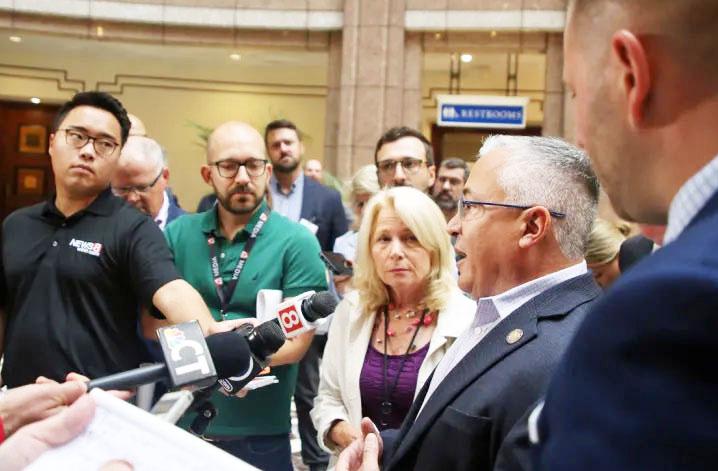
Polletta, R-Watertown, asking how much of a reduction in their monthly bills consumers could anticipate as a result of the bonds.
Consumer Counsel Claire Coleman answered that the anticipated savings was between $5 and $10, though she added that was a conservative estimate.
“Because it depends on the type of customer you are — residential, commercial, which utility provider you have — there is a range and some will go above that,” she said.
Following the meeting Lamont said that the bonds plus reduced generation rates spelled good news for consumers.
“What’s not so good news is that July was probably the hottest July in recorded history or close to it, so a lot of air conditioning is up,” he said. “We’ll see what happens to your final bill, but rates are going down as of July 1.”
Polletta, joined by House Minority Leader Vincent Candelora, R-North Branford, at a separate media briefing, called the bonds “a good first start” but said the action doesn’t go far enough.
“Republicans have been calling for reducing that public benefits charge even
further and getting a lot of those items into the General Fund where we can debate them, we can have a public hearing, and we can vote on them as part of our budget,” he said.
In response to a follow-up question, Polletta added that eliminating the charges would also be an option should the charges be part of the state budget. Candelora, in response to a question about utility bills becoming politicized, said the beginnings of the politicization came when the state instituted more transparency into consumers’ electric bills.
“So people can see what they’re now being charged,” he said. “Now that they know, and the jig is up, it needs to be restructured. And what I would say is, the legislature should be voting on these programs and understanding the cost of these programs.”
In other actions, the commission approved just under $1.6 billion to finance several Department of Transportation programs, including interstate highway interchange upgrades in Middletown and Meriden, and numerous bridge repair and replacement projects.












































Lucy Gellman
The City of New Haven has sent a memo to all employees prohibiting the use of public funds for Avelo Airlines flights, marketing, branding, advertising and promotion.
At the same time, a celebrated New Haven cultural organization–Puerto Ricans United, Inc.–has become the latest groups to sever ties with the budget airline because of Avelo’s agreement to run deportation flights for the Trump administration.
The Arts Paper received on Friday a copy of the new Avelo-focused city memo, which was issued by the Elicker administration on Monday. That memo was sent to all city staff and was signed by city Chief of Staff Sean Matteson.
"Until further notice, the City of New Haven is prohibiting the use of public funds for any travel on Avelo Airlines," it begins. "No city departments, offices or affiliated programs may purchase tickets, reimburse travel, or otherwise allocate taxpayer dollars for transportation on Avelo."
That memo continues: "In addition, no city financial resources may be used to promote, market, or partner with Avelo airlines in any capacity. This includes but is not limited to (a) Participation in Avelo promotional events; (b) City-sponsored advertising or co-branding campaigns; (c) The inclusion of Avelo in any city-funded economic development, tourism or public relations materials."
Meanwhile, on Thursday and Friday, represetatives from PRU confirmed that their organization has also cut ties with Avelo, right on the eve of their group’s biggest celebration of the year. That takes place August 9 on the New Haven Green. PRU President Joe Rodriguez confirmed Thursday evening that the group will no longer be working with the airline, which offers direct flights to San Juan, Puerto Rico that were once celebrated by the group's members.
The city memo and PRU decision mark just the latest blow to Avelo, once celebrated in New Haven, since the budget airline signed a contract with the U.S. Department of Homeland Security (DHS) in April. Since May, Avelo has been running deportation flights on unmarked planes out of Alexandria, Louisiana and Mesa, Arizona. During that time, there have been near-weekly protests at Tweed New Haven Airport, Avelo's Elm City hub. "This Is Not The America That I Believe In"
For both the City and the two cultural institutions, it was past time to cut ties with what some advocates have referred to as "ICE Airlines." That seemed especially present this week, as community members rallied for Esdrás R., a rising junior at Wilbur Cross High School who was arrested by ICE agents during a workplace raid in Southington.
This week, one of Avelo’s unmarked planes normally used for deportations was also used by the company for a com-

mercial flight from Tweed to Florida.
According to the Washington-based organization La Resistencia, that plane "was involved in at least 109 ICE Air flights in less than two months," eight of which were deportations to Guatemala, El Salvador and Honduras.
Rodriguez said that PRU reached the decision to cut ties with Avelo earlier this year, during a board meeting that coincided with the news that Avelo had signed a contract with DHS and would be running deportation flights out of Mesa, Arizona starting in May (read more about that here and here). At the same time, Rodriguez flagged an online petition from the New Haven Immigrants Coalition that had begun to circulate, urging signatories to take a pledge not to fly Avelo.
"The board voted in solidarity to stand with our community," he said at the group's annual gala Thursday night (hold tight for a full article on that star-studded event). "Our community is not just the Puerto Rican community. It's the greater New Haven community."
He noted that the vote was a proactive one: PRU had not yet entered into conversations with Avelo about its 2025 Festival Puertorriqueño, scheduled for August 9 on the New Haven Green. In both 2023 and 2024, Avelo supported both its gala and festival, providing free round-trip tickets and sponsorship.
"We said, should it come up, we were not going to accept it," Rodriguez said. "This is not the America I believe in. It's unfortunate that we have some leaders in our country that choose to divide us rather than inspire us."
“Antithetical To Our Values As A City”

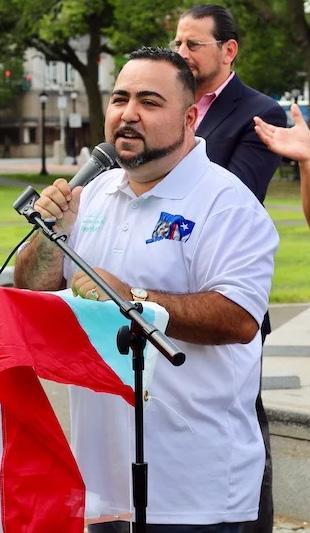
In a statement Friday afternoon, Mayor Justin Elicker expanded on his administration’s decision to issue a memo barring city employees from using public monies for Avelo or Avelo-affiliated activities and events.
“New Haven is proudly a welcoming city for all our residents,” he said. “Avelo Airlines’ continued participation in and profiteering from the Trump Administration’s inhumane and often illegal immigration policies and ICE’s deplorable tactics is antithetical to our values as a city, and not something we will support with city funds or taxpayer dollars.
“Until Avelo Airlines changes its policies and practices, municipal employees are prohibited from using public funds for any travel on Avelo Airlines or using
in deportation isn’t just hypothetical, she said: it’s directly affecting people in New Haven and Connecticut.
She pointed to Esdrás’ ongoing case as an example. Since last week, he has been transported to Massachusetts, New Hampshire, and Louisiana, and allegedly back to New England.
“Avelo is part of that,” she said. “We can't in good conscience continue to use Avelo, so I’m grateful that people are starting to realize that.”
“I think it's important to see our City of New Haven standing up for what's right,” she said. “It's maybe taken a little bit [of time] for folks to see what Avelo is doing, and it's exciting to see this collective consciousness building.”
“It’s definitely a start,” added C4D Organizer Eric Cruz López. He wondered aloud what ultimately prompted the city to send the memo, and why city officials had not made the call earlier in the year, as ICE arrests unfolded in New Haven’s Hill, downtown and Fair Haven neighborhoods.
“New Haven is not the end, it’s only the beginning,” he added, noting the number of groups that still partner with Avelo (it is, for instance, the default airline for UConn Athletics, despite a number of undocumented students at the school). “How do we stop using not only New Haven city money, but statewide money, especially when we have the Trust Act?” In a phone call earlier Friday, New Haven Immigrants Coalition member Anne Watkins echoed that approval. Just as she was grateful to see the Faxon Road Race drop Avelo sponsorship last week, she was glad to see other groups follow suit.
"You know, budgets are values statements, and every organization makes decisions about not just how to spend their money, but where their money comes from," she said. "We know that right now, Avelo is operating as 'ICE Air.' ... Organizations are standing up and saying that the dollars that we get from you is not enough to say that the organization is complicit in the deportation machine."
"This is not just a few people screaming on a street corner," she added. "This is a big deal."
city resources to promote, market or partner with Avelo Airlines. Travel should be about bringing people together, not tearing families apart.
“Prior to Avelo’s decision to contract with ICE to charter deportation flights, the City of New Haven had a very strong partnership with Avelo and it’s truly unfortunate that they have chosen this path, and we continue to urge Avelo to reconsider this unethical and misguided business decision.”
"Budgets Are Values Statements"
In a phone call Friday afternoon, Connecticut Students for a Dream (C4D) Executive Director Tabitha Sookdeo praised the city and PRU for the decision to sever ties with the airlines. Avelo’s complicity
In an email Friday morning, Avelo spokesperson Courtney Goff called the city’s memo and the PRU decision "unfortunate." She did not comment further on the dropped sponsorships and the airline's decision to work directly with Immigrations and Customs Enforcement (ICE), a process during which migrants are shackled at the hands, wrists, feet and waist, as if they are no longer human.
"We look forward to utilizing those funds to benefit other events and philanthropies in Connecticut," Goff wrote. "It’s unfortunate they made this decision, but there are a lot of opportunities and organizations in CT that Avelo would be happy to join forces with and those organizations.

Lucy Gellman
In the months before finishing his sophomore year at Wilbur Cross High School, Esdrás R. was the kind of student every teacher dreams of having. He was bright and attentive in the classroom, as interested in supporting his peers as he was in the work in front of him. He pushed himself to improve reading and writing skills in English. He was never late to class. He made time for advocacy, envisioning a more just world for all immigrants as a member of Connecticut Students for a Dream. He was supposed to spend this month getting ready for his junior year, which begins in late August. Instead, he has disappeared into the country’s increasingly authoritarian immigration system, shuttled from Massachusetts to New Hampshire to Louisiana without any semblance of due process.
It’s not just cruel: it’s fundamentally not American.
That message came again and again to Mitchell Drive on Wednesday afternoon, as hundreds of teachers, students, legislators, faith leaders and immigrant rights activists advocated for the safe and swift return of Esdrás to his New Haven community over a week after he was arrested and detained by Immigration and Customs Enforcement (ICE) agents during a workplace raid in Southington.
Officials are holding Esdrás in the Alexandria Staging Facility in Alexandria, Louisiana. The prison, which USA Today has referred to as one of the Trump Administrations main “deportation hubs,” has a built-in airport that deports migrants—including on planes owned and operated by Avelo Airlines, which also flies out of Tweed Airport. There is currently a GoFundMe to cover his legal fees: donate to it here.
Amidst cries of “El pueblo unido jamás será vencido!” and “When immigrant rights are under attack, what do we do?/ Stand up fight back,” speaker after speaker stressed the profound, unconstitutional and alarming inhumanity of ICE’s actions, in which a New Haven teen was taken from his workplace, shuttled between detention facilities across three states, and not allowed to speak with his lawyer or family for several days.
“These arrests are not happening in far off detention centers,” said Connecticut Students for a Dream (C4D) member Melany Yunga, a fellow student at Wilbur Cross. “They’re happening right here in our neighborhoods. In workplaces. At schools. In homes. And even on the street during routine traffic stops. They happened last week, with our fellow student and community member Esdrás.”
“Esdrás is a student, a son, and a good member of our community,” she added. “He doesn’t deserve to be locked up. No one does. And we will fight until he is free. We must continue to raise our voices ... because this is just not right. This is just not fair. This is just not human.”
It comes as ICE agents ramp up arrests
across the state, including in New Haven. Earlier this month, CT Public reported that ICE has made 247 arrests in Connecticut since Donald Trump’s inauguration in January of this year (advocates have noted that the number is likely low). That includes the horrifying arrest of Nancy Martinez, a New Haven mom of two who ICE took in front of her young children last month, and deported to Mexico in shackles and chains.
Wednesday, some of the most powerful voices—and actions—were those of Esdrás’ peers, fellow New Haven Public Schools students and recent graduates who have been deeply shaken by the disappearance of one of their own. Alongside teachers and groups like C4D, Unidad Latina en Acción, and the New Haven Immigrants Coalition, they have been calling for the release of their classmate, with the understanding that it could be just as soon one of their friends.
This is not the first time a Wilbur Cross student has been taken by ICE: in 2019, junior Mario Aguilar Castañon was also arrested and detained. After significant advocacy and pressure from his peers, teachers, lawyers and organizers in New Haven, he returned home in January 2020. Before the speaking lineup even began, friends Cara Wilson, Adlin Rizal and Jonaily Colón gathered in a huddle, eager to accept signs that read “Bring Esdrás Home” and “Hands Off Our Immigrant Students” from Sierra Fox, the new cantor at Congregation Mishkan Israel. Wednesday, all three said they came out because—after months of believing that Connecticut was immune to such violence—they realized how quickly a person’s life can be completely upended.
“I just feel like it’s really important to come out and show support,” said Rizal, a graduate of Hill Career Regional High School who will begin her studies at UConn in the fall. “I think a lot of us felt like we were safe in Connecticut.”
“That could have been one of our friends,” Colón chimed in. This fall, she’ll be starting her senior year at High School in the Community. She’s worried for her peers, New Haven Public Schools students who represent multiple cultures, languages, and countries across the globe. That fear, and a righteous indignation that accompanied it, echoed over and over again. A recent graduate of Wilbur Cross and a former student representative on the New Haven Board of Education—and the proud child of an immigrant mom—John Carlos Serana Musser pointed to New Haven’s diverse and multilingual student body as a source of pride, rather than a data point that should ever attract the attention of federal immigration officials. Despite the funding hurdles that richer, whiter districts may not grapple with, he is grateful for a student body that is “effortlessly diverse,” with half a dozen languages spoken and just as many beliefs in any given room. What he sees in Esdrás’ migration story, his advocacy, and his commitment to learning is a journey that

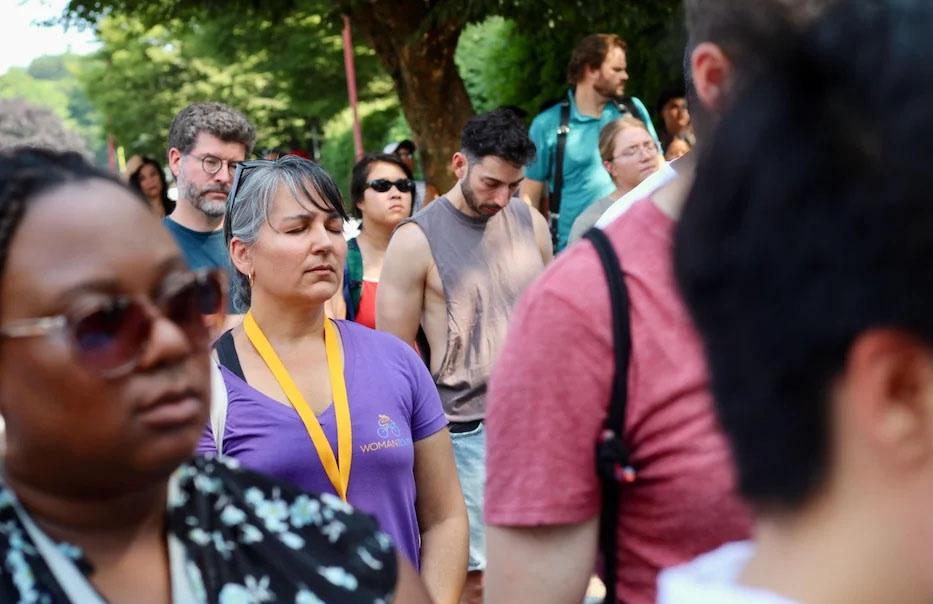


is fundamentally American in its scope. “I always found that diversity not only brings strength, it gives us hope,” he said, pointing to the 60 languages spoken in the New Haven Public Schools, and the hundreds of students who joined in advocacy efforts this year. “Diversity can teach us patience, endurance, and empathy. Diversity is the education of humanity and community … Why are we criminalizing, instituting fear, out of the American story?”
Nowhere, perhaps, was that clearer than in an action at the end of the speaking lineup, done almost entirely in silence. As the clock inched towards 4 p.m., 11 teens—most of them NHPS students and recent graduates, wearing medical masks to obscure their faces—emerged in chains and zip ties, their hands painted red as they held signs that read “Bring Esdrás Home.”
The image—of New Haven’s children in chains, their wrists straining against the thin plastic bands—recalled similar protest actions, from those of designer Willy Chavarria at Paris Fashion Week to artist-activists in Los Angeles, as the National Guard descended on the city during mass immigration raids earlier this summer. It was organized by Ambar Santiago-Rojas, a member of the New Haven Immigrants Coalition and the Semilla Collective.
“As a student, it’s hard to focus while thinking of the family of Esdrás,” said Santiago-Rojas, who is herself the daughter of immigrants, and graduated from ESUMS in June. “The thought of how it is being torn apart keeps creeping in.” She urged attendees to step up, and not just on their Instagram and Facebook feeds. Instead of keyboard warriors, she wants to see dedicated action, from an economic boycott of business that support deportation, cruelty and genocide at home and abroad to showing up at actions and organizing meetings. “Wake up and do not wait until it’s your parents, siblings, cousins, friends.”
As students stood, Bridgeport-based C4D organizer Eric Cruz López explained that the action referenced the inhumane five-point restraint system— which includes shackles on the wrists and angles—in which migrants are often placed as they are transported between prisons and put on deportation flights without due process.
That message flowed through the whole event, from a call from Pastor Josh Williams to remember what it was like to be a high schooler (“one thing you probably didn’t go through was one day thinking that you would be stolen, kidnapped, taken, and not know where you were going,” he said with an edge of anguish in his voice) to a poem from Andreina “Andi” Barajas Novoa, an organizer whose own Mexican heritage has informed their work.
“I want you to use this journal to draw out your wildest dreams. Dream big,” they urged toward the end of the rally, reading from a poem in both English and

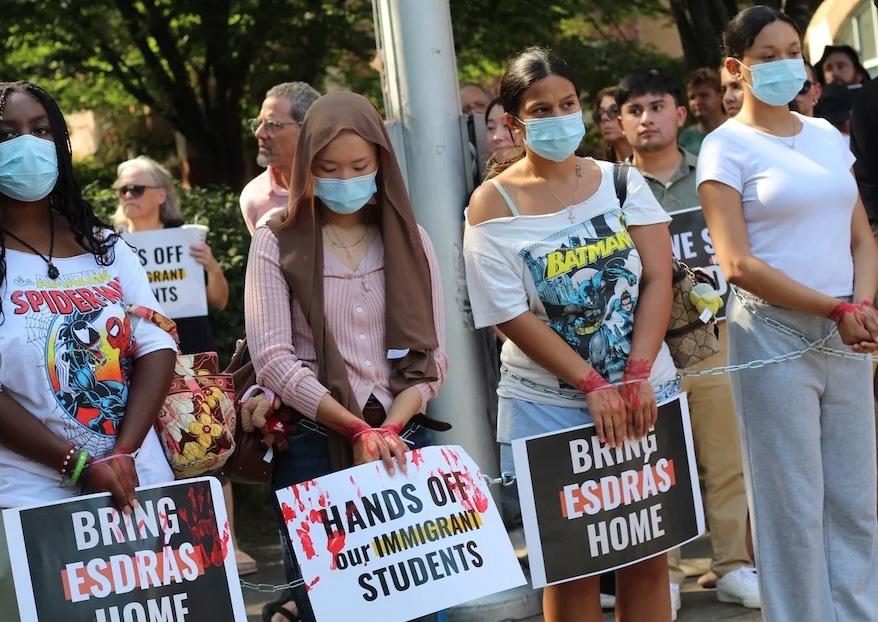

Spanish. “My parents taught me that love is all you need to live a life full of happiness. We will live to see the sunrise; we will live to watch the clouds gracefully pass above us; we will live to play with the stray cats who call our backyards their home.”
“We will live to laugh until the sunsets and then afterwards we will sleep to wake up the next day and live some more. We will live long enough until life
New Haven from Mexico as a child, repeated the words back, sometimes on the verge of tears. As the eldest of five children, she was often a de facto translator for her parents and a caretaker for her siblings, a role that she still takes on as second nature. Although she and her parents are now citizens, she said, “the fear never goes away.”
“This could have been me or my family years ago,” she said. “It never goes away, that fear of needing to look over your shoulder, even though you have this paper that says you have citizenship.”
That anger extended to legislators who attended, some cheering along from a swelling crowd as others to the mic. In addition to statements from U.S. Rep. Rosa DeLauro, U.S. Sen. Richard Blumenthal, and Mayor Justin Elicker, multiple elected officials took the mic, their emotion sometimes raw and palpable as they spoke.
“What we’re seeing right now are a bunch of thugs, hiding their faces,” said State Sen. Gary Winfield, who slammed colleagues in the state legislature who have remained silent on the issue. As he hoped aloud for Esdrás’ safe return, he pointed to the racism, the inequity, and the fundamental lack of empathy that is baked into not just the Trump Administration’s policies, but into the bones of America itself.
“They’re kidnapping our friends, they’re kidnapping our sons, our daughters, and for what?” Winfield said aloud. “This is a nation that has always had an immigration policy that was exclusionary … that was built, just like this nation, on imperialism and racism … This has nothing to do with what’s best for this country.”
Throughout, multiple educators and administrators also came forward to speak about the work that the district is doing to prepare students and teachers to prepare for potential immigration raids as school resumes in late August. In January of this year, Trump rescinded a policy that marked schools, hospitals, and houses of worship as off-limits to ICE.
Leslie Blatteau, president of the New Haven Federation of Teachers, recalled a number of “Know Your Rights” trainings for NHPS teachers, administrator and staff earlier this year, as Trump took office after a campaign built on anti-immigrant rhetoric and fear mongering. The hope of those, she said, was to equip every NHPS staffer with the skills to protect their students.

Many families are struggling to afford the essentials right now. If you’re looking for ways to lower your energy bills, talk to us. We’ve got solutions to help.
• Payment plans and special rates to help you manage today’s bills.
• No-cost programs like Home Energy Solutions, to manage your energy use and improve comfort.
• Ask us about My Account and our Energy Analyzer tool.
If you rent, if you own your home, or if you’re a property owner whose tenants are experiencing economic hardship, let us help. Home Energy Solutions offers no-cost solutions for income-qualified customers. Call 877.WISE.USE or
tells us we have had enough; at which point, our souls will exist amongst the clouds, the grass, and every beautiful soul we met while we were alive. Today, and everyday thereafter, we will live and love until we can't anymore.”
After nearly every speaker, hundreds of voices joined in the same chorus: “Bring Esdrás Home!”
Ana Paola Juarez, a member of the New Haven Immigrants Coalition who came to
“We were told that we will not cooperate with ICE, we will make sure they have a warrant, and we will turn them away because our schools need to be safe for our students.”
“We are committed to making sure our students feel safe living, working and going to school in this city,” said Magda Natal, who taught Esdrás in her classroom at Wilbur Cross. “He [Esdrás] should be looking forward to starting his junior year here, at Cross. Not worrying about how to get back home to New Haven.”
by Adam Walker
A years-long breakdown in communication between the Yale University Police Department and New Haven’s Civilian Review Board (CRB) came to light on Monday evening, as CRB members pressed Yale Police Chief Anthony Campbell to explain why their calls for oversight had gone unanswered despite clear obligations in local law.
The exchange took place during a special meeting of the CRB, held at City Hall and via Zoom, where tensions centered on a long-requested Memorandum of Understanding (MOU) that would grant the board formal authority to review public complaints involving Yale police officers. Although a 2019 ordinance explicitly grants the CRB authority to oversee “civilian complaints of police misconduct by police officers empowered to act with municipal police powers in the City of New Haven,” board members said Yale has never followed through on its obligations under that law. Despite repeated outreach over several years, they said, the university has failed to establish any formal process for communication or oversight.
“I joined the board a few years ago, and from the start, one of the main concerns was the lack of response from the Yale University Police Department,” said CRB member Germano Kimbro. “Several letters were sent, and I was told there was no response and this is going on for several years.”
Kimbro, who has worked closely with police departments in community-building initiatives, emphasized that his concerns stem from a desire for accountabili-

ty, not animosity toward law enforcement. Campbell acknowledged the department had not responded to the CRB’s past outreach and said he had missed prior invitations to collaborate due to overwhelming email volume during periods of protest and crisis on campus.
“We should have had someone here. I’m not making any excuses,” he said. “Sometimes I get over 100 emails per day.”
Campbell confirmed that Yale’s internal Police Accountability Board which previously served as its main oversight
body has been inactive since late 2024 and is currently being revamped with no clear timeline for return. He also reiterated that YPD shares police authority through the city Board of Police Commissioners and operates similarly to the city’s own force.
The Yale Daily News had reported that the university’s longstanding Police Advisory Board, which included student and community representation, was quietly discontinued last year. The board had not met in months, and its operations appeared to dissolve amid leadership turnover, protests, and the graduation of student members.
Currently, YPD has 93 sworn officers and follows internal complaint procedures through its Professional Standards Division. According to Chief Campbell, all complaints are logged and reviewed, with complainants receiving a tracking number and confirmation within 48 hours. More serious allegations classified as Class 1 or 2 complaints, such as excessive force trigger formal investigations, mirroring the process used by the NHPD
Still, CRB members stressed that internal mechanisms are no substitute for independent oversight especially when it comes to transparency for members of the broader New Haven community, not just Yale’s campus.
Campbell said Yale is actively reviewing its systems not only its internal accountability board but also broader alignment with NHPD policies, particularly around shared jurisdiction, protest response, and complaint protocols.
“There is room for improvement. The university is always trying to do better,” Campbell said, adding that YPD is working to improve communication, clarify who responds to what incidents, and streamline coordination with city agencies.
Yet when pressed on whether any version of Yale’s accountability board currently exists, Campbell confirmed that it does not. He was also unable to provide a timeline for when the new board would launch or when a draft of the long-delayed MOU might finally be shared with the CRB.
For now, the relationship between Yale’s police force and the city’s civilian oversight board remains uncertain with no written framework yet in place to ensure public complaints against Yale police are reviewed independently.
by Maya McFadden
New Haven Public Schools (NHPS) has put together a draft version of a new artificial intelligence (AI) policy and is working to implement a privacy-protected AI tool with the goal of helping educators and students generate classroom discussion questions, get feedback on assignments, and conduct research, but not plagiarize.
NHPS Asst. Supt. Keisha Redd-Hannans presented an early draft of the district’s proposed AI policy during the Board of Education’s latest meeting at John C. Daniels School last Monday.
The policy which Redd-Hannans confirmed was reviewed by AI is designed to be referenced by teachers and students when making use of AI during classroom instruction.
“It’s here. We have to embrace it,” Redd-Hannans, who is a 2025 Google
GSV Education Innovation Fellow, told the board about AI.
She said that NHPS should only allow AI use if it’s done within a district-vetted AI tool that is “in alignment with our privacy and security guidelines.”
The district policy comes as Redd-Hannans said educators, administrators, and students are already making use of their own AI tools. She emphasized that the tool, once selected and approved by NHPS’ IT department, will aim to improve educator retention through additional instructional support, student toolkits, and operational efficiency.
AI will “support but not substitute” teachers and critical learning, she added. “I think this should be a part of our retention tool kit,” she said.
She said use of AI in the district has already helped make staff more efficient in their work and should continue to do so. But, she said, it must be on a regulat-

they found themselves staying a little longer. They had their first child, a four and a half year old who Sunday delighted in crafts from the Eli Whitney Museum & Workshop. Covid eased, and they didn’t leave. Then two years ago, they made the move from Wooster Square to Beaver Hills. Diallo is now serving as the 202425 Curtis-Liman Fellow at Yale Law School.
“We’re trying to build community here,” he said. Sometimes, he and his wife will get to know “pockets” of the neighborhood—but it can be hard without events that organically bring people together.
“Building community is important to us.”
Sunday, that vision came to life as Kulturally LIT Founder IfeMichelle Gardin fussed over Jad, bringing a bottle of water to his dainty, drool-covered mouth as she beamed and cooed.
“It’s wonderful to see the neighborhood coming together,” she said later in the afternoon. For years, she lived on Carmel Street, in a house that passed from her mother to her. While she’s since moved, she still thinks of herself as a resident of the neighborhood, she said.
Chana Robinson, who grew up in Beaver Hills, framed the block party as a sort of return to a time-honored tradition. When she was growing up on Ellsworth Avenue, Beaver Hills hosted an annual block party on Moreland Road, which now sits in Alder Gary Hogan’s ward. At some point—she doesn’t know when—it stopped.
Meanwhile, she moved away for school, then lived in New York for over a decade. Two years ago, she and her husband moved back with their growing family. For her, the block party was a chance to get to know neighbors who don’t always make time to talk to each other.
“You can live your life next to someone and never meet them,” she said, watching as one of her daughters settled into Kelsey Mastroianni’s creative chair, and morphed into a cat with the help of some face paint.
ed NHPS-approved tool to avoid giving companies access to students’ private information.
NHPS’ AI policy committee was made up of teachers, administrators, central office staff, and the IT department. The IT department is currently working with the city to select the specific tool NHPS will use.
The proposed policy states, “AI can serve as a tool to support learning but it will never replace the essential human capacities (critical thinking, creativity, communication, empathy, and resilience).”
Redd-Hannans said it is crucial that when using AI, staff and students avoid “plagiarism and propagation of misinformation, bias, or harmful content.” She said all use of AI must be cited.
She encouraged the use of AI for les-
Con’t on page
Around them, the party showed no sign of stopping. Beyoncé’s “Texas Hold ‘Em” bounced over the street, and a block away a couple rose and began to dance. Beneath his tent, DJ Tootskee shrugged off a few drops of rain and kept the tunes coming. Across the road from him, fish done two different ways cooked beneath tents from Betty Alford and Nir Bongart and Mendy Katz.
“It’s very nice!” said Bongart as he flipped over cuts of fish, the skin crisp. Three decades ago, he moved to Beaver Hills for his studies at the University of New Haven. Staying wasn’t initially part of the plan, he said. But he never left.
“I’m still here, so it’s a good time,” he said with a smile as Tootskee jogged through the rain, now no longer a drizzle, to get a salmon sandwich. He lifted a cut of fish onto Tootskee’s plate. “I got you, my man.”

by Laura Glesby
Nearly one thousand people rallied beneath the sweltering sun Tuesday evening to send a resounding message to Yale University: that as research funding cuts take effect and a substantial endowment tax looms, now is the time to invest further in New Haven not to retreat or withhold.
Affiliates and allies of New Haven Rising, the economic justice advocacy partner of New Haven’s UNITE HERE unions, filled Scantlebury Park in the 93-degree weather to call on the university to contribute more funding to New Haven.
Yale is facing an 8 percent endowment tax passed recently by Congress. In a July statement, Yale President Maurie McInnis wrote, “This is money that would otherwise support our students, faculty, staff, and local partnerships with the city of New Haven.”
On Tuesday, activists maintained that lost or threatened funding does not absolve the university from an obligation to contribute more to New Haven.
“Even in a moment of great funding cuts,” said New Haven Rising organizer Abby Feldman, “there is more than enough to go around.” She pointed out that the institution with an endowment amounting to more than $41 billion has raised over $6 billion in its ongoing “For Humanity” fundraising campaign alone. Attendees included hundreds of members of UNITE HERE Locals 33, 34, 35, and 217; a dozen New Haven Public Schools educators; a wide range of activist organizations advocating for tenant power, immigrant protections, climate interventions, and transgender rights; and politicians ranging from the mayor to state representatives to many members of the Board of Alders.
Over the course of an hour and a half, attendees called for more funding to address a wide range of needs in New Haven, including more affordable housing, more jobs that pay a livable wage, broader access to healthcare, and safer neighborhoods.
They cheered, raised signs, guzzled wa-
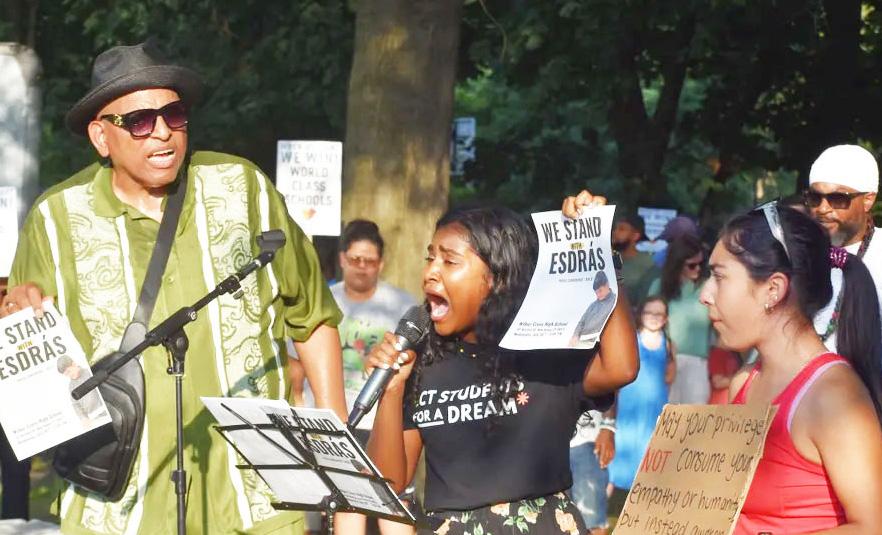
ter, and at times found the energy to dance in the blistering heat.
Tuesday’s rally took place as a six-year, city-Yale deal announced in November 2021 and approved by the Board of Alders in April 2022 enters its final years.
That agreement saw Yale commit to increasing its voluntary payments to New Haven by $10 million per year during the first five years of the deal, and by $2 million in the sixth year. It also saw Yale dedicate $5 million to create a new Center for Inclusive Growth, agree to a phase-out property tax-payment schedule for properties Yale acquires and takes off the tax rolls, and commit to converting a portion of High Street downtown to a pedestrian and bicycle-only plaza. (Yale has subsequently paused that last endeavor amid uncertainty around federal funding under the Trump administration.)
Local refugee advocate Jane Kinity said she stumbled upon the protest while on break at her job at Yale’s nearby student health center on Ashmun Street. Spot-
help lead Tuesday's New Haven Rising rally.
ting several hundreds of people filling the nearby park, Kinity wondered “what was going on” then learned that New Haven Rising was advocating for Yale to contribute more funds to the city. A proud Local 35 member, Kinity said, she decided to spend her break amongst the crowd. “We have youth in the community” who need more resources, she said.
New Haven Federation of Teachers President Leslie Blatteau reported that “only 8 percent of our members believe we have enough staff” in New Haven Public Schools, and “only 10 percent of our staff” believe they are sufficiently compensated for their work.
“The state of Connecticut has extreme wealth. Yale University has extreme wealth,” she said. She called on the state, Yale, and the “14 billionaires” living in Connecticut to redistribute some of their resources to public schools and to the people struggling the most. “Working people built this nation,” she declared to resounding cheers from the crowd.
High School in the Community student Jonaily Colon, who is one of the two student representatives on the Board of Education, said that when she and her classmates return to school this fall, “We will see a devastating change. Many electives we have in our schools will no longer exist. Our class sizes will increase. … We will be facing new challenges as our classrooms continue to get hotter and the mold continues to become hazardous to our health.”
She sketched a vision of the future in which “our fully funded schools will have basic school supplies” with well-resourced art and music education. “Our fully-funded schools in the future won’t have leaky roofs and moldy classrooms. They will be welcoming and well-maintained,” said Colon. “We won’t have to worry about our teacher finding a trash can or bucket to collect the water or numerous puddles in our school.”
These words resonated with several of the current high school students or recent
graduates who attended the rally.
Reily Hosten, a student at the state’s Eli Whitney Technical High School in Hamden, noted that “my school was in danger of not having funding for summer school.”
Recent Wilbur Cross graduate Jordell Wynn recalled, “At Wilbur Cross, we suffered leaks in the ceilings, mold in the classrooms.”
He recalled attending classes at Yale through the university’s Shafer Scholars program for New Haven high school students, and noticing a stark difference in the quality and safety of the university classrooms compared to those in his school.
Meanwhile, another loss that Colon fears her classmates may encounter this fall is the absence of Esdrás, an 18-yearold Wilbur Cross student whom Immigration and Customs Enforcement (ICE) arrested and detained last week.
“Esdrás made so many sacrifices. So we, students of New Haven, community members, and activists, are now willing to sacrifice what we can to bring Esdrás back to our community,” Colon said to a roar of support from the crowd.
Connecticut Students for a Dream Executive Director Tabitha Sookdeo, who has been advocating for Esdrás, led a calland-response plea: “ICE out of Connecticut! ICE out of New Haven!”
Rev. Scott Marks, the director of New Haven Rising, urged attendees to consider their own freedom as intertwined with the freedom of their neighbors. He pointed specifically to LGBTQIA+ and immigrant community members as frequent targets of stigma who should be embraced by New Haven Rising’s movement. “I was upset when Yale New Haven Hospital cut out the [medication-based] healthcare” for transgender youth, he said. And immigrants are “not coming to take our jobs, they’re coming to help us make our jobs better.”
“My issue is our issue. Your issue is my issue,” echoed Feldman.
Correction: Yale is facing an 8 percent endowment tax; the article originally cited an initial proposal for a 21 percent tax.




Yale New Haven Hospital is pleased to offer patients and their families financial counseling regarding their hospital bills or the availability of financial assistance, including free care funds.
By appointment, patients can speak one-on-one with a financial counselor during regular business hours. For your convenience, extended hours are available in-person at Yale New Haven Hospital once a month.
Date: Monday, August 18, 2025
Time: 5 - 7 pm
Location: Children’s Hospital, 1 Park St., 1st Floor, Admitting
Parking available (handicapped accessible)
An appointment is necessary. Please call 855-547-4584.
Spanish-speaking counselors available.
Evergreen Cemetery & Crematory We’re Here When You Need Us!
• Cremation (Choose to be cremated at Evergreen.)
• Columbarium in the Most Beautiful Cremation Garden
• Reserve your Niche in a secure location pre-need.

• Reserve a Niche for family and friends or purchase at-need to safely place your Loved One in the Columbarium.
• Burial Lots (infant, single, two-grave, or four-grave)
• Monuments & Markers (black, gray, or pink granite)
• Flower placement (single or multiple placement)
• All orders can be placed at the Evergreen office or the website.

by Jamil Ragland
HARTFORD, CT — Surrounded by state and federal officials and advocates, Gov. Ned Lamont had a blunt message for President Donald Trump.
“Homelessness is not a crime. Not here in Connecticut, and not here in America,” Lamont said Monday at a press briefing in the State Capitol. He added those experiencing homelessness “need help, not handcuffs.”
Lamont and the others denounced Trump’s recent executive order prioritizing enforcement actions against unhoused people. It calls on the Attorney General to “[shift] homeless individuals into longterm institutional settings” through the expanded use of civil commitment for what the administration refers to as individuals who suffer from serious mental illness and substance abuse problems. It also calls for increasing homeless encampment removals and increasing funding to courts to process those cases. Those at Monday’s briefing described the order as “cruel” and vowed to assist unhoused people and families.
“Let’s be abundantly clear: the recent executive order issued by the federal administration raises some serious concerns for housing, mental health care, and the rolling back of decades of progress in public health and deinstitutionalization,” said Department of Mental Health and Addiction Services commissioner Nancy Navarretta. “The executive order would effectively criminalize homelessness and


reduce support for incredibly effective programs that use a ‘housing first’ model. This does nothing less than suggest lessons from history, science, and basic human compassion have been rejected.”
State Rep. Kadeem Roberts, D-Norwalk and co-chair of the End Homelessness caucus in the General Assembly, said the executive order hurts American families and urged federal officials to get a firsthand look at the problem.
“I do want to say to the administration at the White House, you guys need to come outside and take a walk through these shelters,” he said. “Take a walk through these streets, where these people are really suffering.
”The caucus’s other co-chair, Rep. Lau-
rie Sweet, D-Hamden, shared the story of a man she referred to as “Mr. A,” and how she assisted him in his journey out of homelessness. She said her hometown passed a resolution declaring that housing is a human right, and it had an impact on her constituent’s outcomes.
“All I can think is, without our resolution, what would have happened to Mr. A if the police found him in the park?” she asked. “What would have happened to him in a different town? Would he be arrested, ticketed, put in jail, his belongings swept, and thrown in a dumpster? And what would this accomplish? Would he pay a fine? How would he do that? How would he get future housing?”
She described the executive order as the wrong approach.
“I know in this very democratic state of Connecticut, this is not our approach,” she said.
Some of the advocates who spoke also had firsthand experience with being unhoused. Jennifer Paradis, executive director of the Beth-El Center in Milford, shared her story of experiencing homelessness in high school as result of extensive medical bills from her younger sister’s death.
“My parents were who we are talking about here today,” she said. “They were unsheltered. They were living in their
van, working five jobs between the two of them. It took over four years to regain shelter.”
Both her parents died prematurely from health complications related to homelessness, Paradis said.
“So thank you so much for standing here today for people like my parents and the thousands of people who are experiencing homelessness in Connecticut,” she said. While some speakers at the event called homelessness a housing problem, others pointed out that Lamont vetoed the omnibus housing bill passed by the General Assembly in June. The bill included provisions to increase the state’s housing supply, as well as funding for homelessness programs.
“We appreciate Governor Lamont’s words but will not be heartened until we see him act. We cannot address homelessness without housing and we cannot build enough housing until we start to tear down the red tape and regulatory barriers purposefully erected by many local officials who choose not to permit home construction in their towns,” according to a joint statement from the leadership of eight housing advocacy nonprofits across the state.
Lamont was asked directly about the apparent contradiction. He replied that he was still committed to passing a bill “that we can all get behind.”
“We’re working on that every day,” he said. “We’re going to get a really good housing bill that has the support of all the people in this room, and makes sure we make a difference.”
by Sonia Ahmed
The city is looking for members of the public to adopt all 2,652 hydrants in New Haven.
Adopters are responsible for trimming the grass around the hydrant, keeping it clear of snow and ice, reporting damage or water leaks, and painting the hydrant. While yellow is the default color for city hydrants, adopters can work with the fire department to pick a hue of their own.
On Monday, Mayor Justin Elicker, Fire Chief John Alston and Asst. Fire Chief Daniel Coughlin joined Umberto 2nd Club (which had adopted its own fire hydrant) members and Youth @ Work participants at 231 Chapel St. for a press conference to discuss the city’s AdoptA-Hydrant Program.
Residents, businesses, and organizations can adopt a hydrant by filling out this form through the city’s Department of Fire Services with information about where the hydrant is located, their email address, and a phone number.
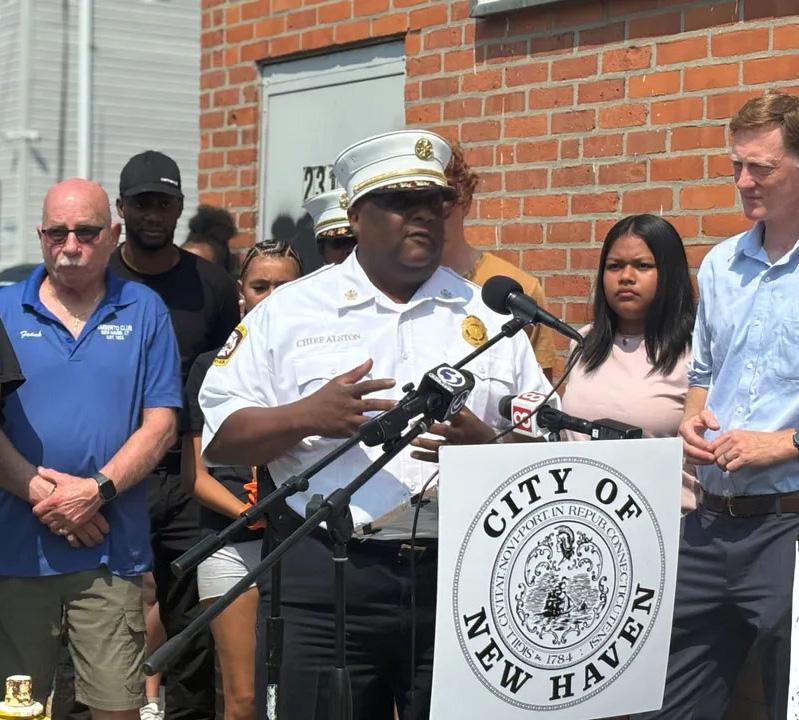
The Adopt-A-Hydrant program ensures that the hydrants are operable, accessible, and visible, according to Coughlin.
“A fire triples in size every 30 seconds it doesn’t have water on it,” he said, emphasizing the importance of fire hydrants.
Sure enough, not every city fire hydrant is yellow, even though that is the city’s default color.
The New Haven Parking Authority, for example, adopted all the hydrants near their properties and painted them the authority colors, blue and white, according to mayoral spokesperson Lenny Speiller.
The paints can be picked up at any local fire house in the city. Four hundred hydrants have already been adopted by around 80 residents, according to Elicker.
Coughlin added that the fire department is amping up its ticketing of blocked hydrants, and that they are averaging 120 – 150 tickets per month.
“It’s not about getting money, it’s about
getting a car away from a hydrant,” Chief Alston said.
In recent years, Youth @ Work program participants have painted around 1,200 hydrants, according to Elicker. 17 Youth @ Work participants were in attendance for Monday’s press conference.
“It just makes me happy because the city is looking brand new, better than it was before,” Youth @ Work participant Shonali Sing said regarding her experience painting hydrants.
Elicker stated that besides the AdoptA-Hydrant program, the city has allocated $400,000 in American Rescue Plan Act funds to replace 50 fire hydrants, with about $8,000 being spent per hydrant.
“There’s a sense of pride that you feel,” Elicker said about painting the fire hydrants. He concluded Monday’s press conference by joining two Youth @ Work participates in repainting a fire hydrant bright yellow.






by Lisa Reisman
It was, as Mayor Justin Elicker put it, a true Elm City story. Lifelong New Havener Ashley Bailey returned to the house where her father and grandfather raised her as a baby not as a renter, but as a first-time homeowner, and landlord as well.
“Now life has come full circle,” Bailey told a group of 60 well-wishers from her new front porch, festooned with banners and balloons, on 470 Howard Ave. Tuesday afternoon.
The occasion, a ribbon-cutting, celebrated the latest home restoration by the Neighborhood Housing Services of New Haven (NHS), as well as Bailey’s steadfast determination to realize her dream of homeownership in the very neighborhood she was raised thanks to state and federal programs that are at risk of shutting down under the Trump administration.
website to notify our community about our policies and procedures that we do not ask anyone about their immigration status, and we are not working with ICE.”
He explained that Yale Police operate under Connecticut’s TRUST Act, which prohibits cooperation with ICE on administrative warrants. If ICE agents are spotted on or near campus, Campbell said, Yale officers are instructed to respond not to assist enforcement, but to de-escalate tensions and document the incident.
“I do acknowledge that ICE is a law enforcement agency,” he said. “Now, if they had a warrant for a criminal suspect who was dangerous to our community, that’s normal policing. But these administrative warrants that they’ve been serving people we’re not going to be enforcing those.”
Jacobson described NHPD’s stance as “neutral,” emphasizing that the department does not ask about immigration status or act on administrative warrants. He noted that ICE rarely contacts NHPD for assistance and said claims that NHPD declines warrants are misleading because the department is not typically asked to take part in federal actions.
If ICE does alert NHPD to a multi-person operation, Jacobson said, the department might be informed in advance, though such roundups haven’t happened in recent years. More often, ICE agents detain individuals at courthouses after arraignments an approach Jacobson described as safer and less disruptive than pursuing people in the community.
While reiterating that NHPD would intervene if any law enforcement agency, including ICE, used excessive force, Jacobson stressed that otherwise, the department does not get involved.
“We take a neutral stance,” he said. “We protect the people, and we make sure what’s being done is legal.”

“This is an important milestone in our history,” said Jim Paley, executive director of NHS, referring to the NHS-led transformation of the 1882 Queen Annestyle property from abandoned vacant rooming house into owner-occupied three-family home.
Regarding the mission of neighborhood revitalization, he discussed the abundance of absentee owners that own multiple properties in the city. “Where do they concentrate their acquisitions but in the low-income minority communities,” he said. “We need homeownership to balance that out and create a sense of stability.”
Paley registered concern over the future of federal programs like the HOME Investment Partnerships and the Community Development Block Grant (CDBG) that made the rehabilitation possible. “The president’s budget has zeroed them out, and the House budget is a small percentage of what the Senate budget is,” he said.
He called on U.S. Sen. Richard Blumenthal to push for preservation of both programs, as well as NeighborWorks America, the largest funding source for NHS. “If NeighborWorks goes out of business, it would be a great hardship for us,” he said.
Blumenthal then took the stage. “Homeownership is still the American dream, but it’s increasingly out of reach for the average American,” he said. The reason is not just the cost of the home itself, but also, he said, “the increase in our national debt that raises interest rates, the tariffs that increase construction costs like timber and aluminum, the discrimination that makes it more difficult for some people to own homes.”
He pledged to fight for federal programs like HOME and CDBG. “They’re force multipliers, they are a leveraged investment, they are seed money, they are a downpayment that the federal government helps to make, and should continue

to help to make, to ensure the American dream is realized by everyone, and not just a few,” he said.
Mayor Elicker praised NHS for its impact on the city. “If you look at some historically underserved neighborhoods in New Haven, it looks dramatically different because of the work you do,” he said. He encouraged attendees to take a tour of the house. “It is beautiful inside and out, and it will provide Ashley and her family not just with a wonderful and safe place to live, but a real sense of dignity and pride about where they live,” he said. In contrast to its formerly blighted state, “this property will improve the neighborhood as a whole, and will encourage neighbors to take care of their properties, and to have that longevity that will allow them to build relationships with each other.”
Bridgette Russell, NHS HomeOwnership Center managing director, highlighted the discipline Bailey practiced to re-
son planning, creating class assignments, providing feedback on work, conducting research, or challenging students to improve digital literacy skills.
“We should challenge what we see AI generating, not just take it at value,” just like with any other research process, she said.
The draft policy also requires that AI be used under teacher guidance, meaning teachers must clearly state whether they approve or disapprove of AI use for class work.
Redd-Hannans said AI has helped her with her speechwriting, ensuring that her speeches focus on the critical points she intends them to. It also has helped her brainstorm new ideas and create project management timelines.
The draft policy also requires that teachers show students first how to use AI responsibly. This will be possible through two trainings for educators this coming academic year. The American Federation of Teachers (AFT) will offer a training for teachers and admin, and Google will offer professional development in AI responsibility for educators “in order for it to trickle down to our students.”
The district will also aim to provide educators with the equipment necessary for AI use in classrooms to be sure it is accessible to all and that its use isn’t reliant on personal devices.
Redd-Hannans concluded, “We have a commitment that as we move forward we will have an AI committee of staff, students, parents, and community members to guide the integration of AI in NHPS.” The school board hasn’t yet voted on whether or not to implement the policy. In a comment sent to the Independent on Sunday, Board of Education student representative Career High School rising junior Abdellah Aly said, “I want to tell the public that this is NOT a full ban on AI. AI will always be there, no matter what, there is nothing we can do about it, however, we should embrace it, and that is what we decided on.”
alize first-time homeownership, one that had her raising $94,250 in downpayment and closing costs from state and federal programs.
“Ashley was ready and she was serious from the start, and those are the customers that you want,” Russell said.
“She got her fiscal house in order, she got her credit excellent, her savings in line, and most of all she had extraordinary patience in the process.”
With that, she introduced Bailey, “the true star of this story,” she said.
Bailey thanked her father and stepmother for emphasizing the importance of homeownership, particularly, she said, “in the community you live in.”
“As a teenager, I would walk with my friends along the sidewalks and I would dream of owning a house,” she said. “Today that dream came true.”
Aly continued: “AI will ONLY be used for the following: Helping decide if a student’s writing is good, suggestions on possible changes the student should make, and other things that follow in this sort of category. However, students may NOT be allowed to literally copy paste from AI, those students who are caught doing so will face possible repercussions if they cannot defend.”
Aly noted during last Monday’s school board meeting that students in the past have been accused of AI use when it was not used. “AI checkers make mistakes, you could have a fully made hand-written essay that you spent days on and something could get flagged,” he said in his comment to the Independent. “That is why the student whom is reported for such thing will be allowed to explain himself. The use of AI will not be discouraged, it is a tool, and it should stay that way.”
By Stacy M. Brown Black Press National Correspondent
A new Harris Poll report reveals that while Americans overwhelmingly view skilled trades as essential to society, they also believe the field is undervalued, overlooked in schools, and facing a generational perception gap that could deepen the labor shortage crisis already gripping the nation.
According to the poll, conducted June 20–22, 2025, among 2,203 adults nationwide, 91% agree that skilled trade jobs are just as important as white-collar jobs, with 63% strongly agreeing. Still, 86% say skilled trade careers are overlooked in today’s educational system, and 90% believe most people don’t realize how lucrative these careers can be. “Skilled trades offer real career potential, but they’re not being talked about enough in schools or by society at large," said Wendy Salomon, one of the report’s authors at Harris Poll’s Corporate Strategy & Reputation Practice. Despite their crucial role in the economy—from electricians and HVAC technicians to mechanics and welders— skilled trades struggle with image and awareness issues. Younger Americans appear less confident in the opportunities that trades provide. Only 38% of Gen Z respondents said skilled trades offer the best job prospects today, compared to 59% of Baby Boomers. Just 36% of Gen Z strongly agree that skilled trades offer a faster and more affordable path to a good career. The data shows a steep generational divide. While older Americans tend to view trade jobs as viable, even preferable career paths, many younger Americans are deterred by factors such as societal


prestige, college pressure, and uncertainty about pay. Gen Z respondents also pointed to concerns about automation, job security, and inflexible work structures.


Black Americans were significantly more likely to cite a lack of visible role models as a significant barrier to entering the trades, suggesting that diversity and
representation remain challenges in an industry that is still perceived by some as exclusionary. Even with these barriers, the report found a sharp contrast between
perception and reality. Career paths in technology and healthcare dominated perceptions of opportunity, but skilled trades were still among the top five across all generations. Among Boomers, they ranked second only to tech. And even Gen Z ranked skilled trades above careers in law, teaching, and finance. One striking finding: a majority of Americans now say they would advise high school graduates to pursue a vocational or trade school path over a traditional four-year college. Only 36% of Gen Z would recommend college over trades. That figure rises steadily with age, with 41% of Boomers backing trade school routes for graduating seniors. Corporate America is also being called to act. Nine in ten Americans said they have a more favorable opinion of companies that support skilled trades. That sentiment is strong across age groups, political identities, and racial demographics. Respondents said companies should offer hands-on school programs, paid internships, scholarships, and mentorship opportunities. “Skilled labor shortages are not theoretical—they’re disrupting industries today,” the report stated. “Corporate America has a clear mandate. Support the trades not just as a philanthropic gesture, but as a strategic investment.” The poll suggests that employers who step in to fund scholarships, partner with schools, or provide training and apprenticeships can not only build brand loyalty but also ensure a more stable future workforce. “There’s a myth that the trades are for people who couldn’t succeed elsewhere,” said Salomon. “That myth needs to die. These are skilled, in-demand careers that require intelligence, adaptability, and resilience.”
By Stacy M. Brown Black Press National Correspondent
While headlines from CBS News and other outlets claim that crime dropped “in every category” in 2024, a closer examination of the FBI’s newly released data shows that such summaries exclude key categories of criminal activity that remain serious or are getting worse.
The FBI’s 2024 Uniform Crime Report (UCR) shows that the violent crime rate—which includes murder, rape, robbery, and aggravated assault—declined by 4.5% from the previous year. Property crime rates also fell by 8.1%, including decreases in burglary, larceny-theft, and motor vehicle theft. However, a review of the complete FBI datasets reveals that the total number of murders increased, with 16,935 people killed in 2024, up from the previous year. This happened even as the murder rate per 100,000 people dropped from 5.7 to 5.0, reflecting population growth rather than fewer killings. The FBI also reported 40,995 incidents of cargo theft in 2024, including large volumes of merchandise stolen from commercial

vehicles and storage facilities. These cases are not included in the general property crime totals cited in most news coverage.
In addition, 3,725 human trafficking offenses were reported nationwide. While this number remained relatively unchanged from recent years, the FBI and advocates routinely note that trafficking is underreported and difficult to track due to the nature of the crime. More than 8,000 hate crime incidents were reported in 2024. The data show that most known offenders were white. Black individuals, Jewish communities, LGBTQ+ people, and Asian Americans were among the most targeted groups. Hate crimes are reported through a separate FBI system and were not referenced in CBS’s coverage. The FBI also published data showing that 24 law enforcement officers were feloniously killed in the line of duty last year. Thousands of additional assaults on officers were reported, including those involving firearms and knives. The most common hours for assaults were during evening shifts. During a press briefing on the data release, when asked by CBS
News why the violent crime rate had declined, an FBI official responded, “It’s difficult, if not impossible, for us to say why, and each reporting agency would have a different reason why.”
That level of caution comes at a time when Trump removed Bureau of Labor Statistics Commissioner William Beach after the agency released a jobs report that reportedly displeased the White House. The firing has raised questions about the independence of federal agencies and the potential political risks of reporting inconvenient data. While it is factually correct that the rate of reported violent and property crimes decreased in 2024, omitting the raw totals—such as the rise in murders—and failing to account for categories like hate crimes, human trafficking, and cargo theft creates an incomplete public understanding of crime in the United States. The FBI data shows that several serious threats remain. Focusing solely on year-overyear percentage declines without context or complete transparency can mislead the public and obscure the risks that many communities continue to face.
By Lauren Burke
Democratic Leader Hakeem Jeffries flew to Austin, Texas, today to address Texas redistricting. Republicans who control the legislature and the Governor’s Mansion in Texas are working to redraw the congressional district lines after President Trump stated that he thought that five more congressional seats could be created. “Donald Trump ordered Governor Greg Abbott and Texas Republicans to race back to Austin for a special legislative session,” Leader Jeffries said, standing in front of a group of congressional and Texas elected officials.
“Our message to the people of Texas and to this great country is simple: You deserve better,” he added. The Democratic Leader spoke on how the special
session called to focus on redrawing congressional maps to make it harder for Democrats to win should be focused on how people will be impacted by changes to their health care because of the passage of the Trump tax plan. The bill was signed into law on July 4. “This session should be about fixing Texas’ broken health care system,” Leader Jeffries, in part, stated. Texas Republicans gerrymandered a map that revealed a new map that made many congressional maps. Before Texas redistricting, the breakdown on the Congressional map was 25 GOP seats and 13 Dem seats. After the proposed maps, the breakdown would be 30 GOP-leaning seats and 8 Dem-leaning seats. “It is time we all fight hard… If the Republicans say they’re going to gain five seats in Texas, I say we gain 30 seats in New York, Cali-

fornia, and Virginia… in Colorado,” said attorney Marc Elias on MSNBC on July 30. Elians has worked on voting rights law at the pro-democracy organization Democracy Docket.
The fight over the maps in Texas will likely reverberate in other states. California Governor Gavin Newsom is signaling that he is considering a mid-decade round of redistricting. The Texas Tribune reported yesterday that Gov. Newsom “has told aides he will move forward with a plan to redraw his state’s congressional lines to install more Democrats if Texas Republicans pass their own updated map.”
The redistricting issues could cause other political dominos to fall in other states, such as Illinois.
Twitter /Handles: @LVBurke @RepJeffries
By Stacy M. Brown
Black Press National Correspondent
A new poll from the Associated PressNORC Center for Public Affairs Research shows growing public skepticism toward the effectiveness of diversity, equity, and inclusion (DEI) programs. Conducted July 10–14, 2025, the survey of 1,437 U.S. adults revealed that only about onethird believe DEI efforts reduce discrimination against women, Hispanic people, or Asian Americans. Four in 10 say DEI initiatives help address bias against Black people. Yet nearly 30 percent believe these initiatives increase discrimination, including against white people.
The AP-NORC poll also noted a sharp drop in the number of Americans who acknowledge racial discrimination against Black and Asian people. In 2021, 61% said Black Americans faced a great deal or quite a bit of discrimination. That figure now stands at 40%. For Asian

Americans, it dropped from 46% to 30%.
Despite this decline in perception, 74% of Black respondents say their communities continue to experience significant discrimination. The polling results come amid escalating concerns about Project 2025, a sweeping 900-page policy blueprint published by the Heritage Foundation and widely viewed as a roadmap for a second Trump administration. According to the Legal Defense Fund’s Thurgood Marshall Institute, Project 2025 poses a direct threat to Black communities by proposing to dismantle civil rights protections, privatize education, and expand executive power with minimal oversight.
The LDF’s report, Attack on Our Power and Dignity: What Project 2025 Means for Black Communities, warns that the agenda would eliminate racial data collection in federal agencies, weaken anti-discrimination laws, and roll back protections for workers, students, and voters.
“The assault on Black communities envi-
sioned by Project 2025 will almost certainly condemn us to demise,” said LDF President Janai Nelson. Education is a central battleground. Project 2025 calls for eliminating the Department of Education and replacing federal oversight with state control, even in states with a documented history of racial discrimination. It also seeks to defund school programs that address systemic racism or acknowledge white privilege. These efforts echo past segregationist rhetoric.
In a February 2025 Newsweek opinion piece, Dr. Stephanie R. Toliver of the University of Illinois cited former North Carolina Justice I. Beverly Lake’s 1954 warning that inferior education was preferable to racial integration. Toliver drew a chilling parallel to the present: “Just as Justice Lake once saw inferior education as an acceptable price to pay for preserving racial purity, today’s rhetoric proposes that a substandard education is a small cost for maintaining racism, homopho-
bia, trans violence, and antiblackness”. Human Rights Watch also issued a 2025 statement linking the rollback of DEI initiatives to the broader global assault on anti-racism efforts. The organization called the Trump-era movement against DEI a “clear example” of mainstreamed racism, urging governments to reckon with the legacies of slavery, colonialism, and apartheid by adopting reparations and structural reforms. As perceptions of discrimination wane and support for DEI programs declines, civil rights advocates warn that these attitudes reflect not progress, but apathy, denial, and a dangerous rewriting of history.
“Our democracy stands at a crossroads,” Nelson said. “A path of infinite promise towards a more inclusive, equitable, and durable democracy on the one hand, and one of immeasurable and, potentially, irretrievable demise on the other” Twitter /Handles:
@NNPA_BlackPress @BlackPressUSA
Earlier today, over fifty Texas Democratic lawmakers flew to Illinois to try blocking a Republican redistricting plan. Many arrived at O’Hare International Airport, where Illinois Governor J.B. Pritzker and local advocates welcomed them. The lawmakers’ decision to travel to Illinois came a few hours after Governor Abbott called a special legislative session. Initially meant to deal with flood relief, the session saw the introduction of a congressional map redrawing proposal meant to be implemented before for the 2026 elections.
The proposed new map was set to add five Republican-leaning districts. With the strategic move to temporarily relocate to Illinois, Democrats denied the House a quorum, thus stalling the legislative process and vote on the congressional map. Texas Republicans have stated their

intentions to press for a vote as soon as a quorum is regained, while the missing Democrats maintain they will remain out of state for as long as it takes to block the vote.
Governor Abbott has imposed a daily civil fine of $500 for each missing lawmaker, while threatening to arrest the lawmakers and remove them from office if they refused his call to return to the state by 3 p.m. His threat was backed by a 2021 opinion from the Texas attorney general suggesting that the legislature could vote to expel absent members. Many legal minds believe that any attempt to remove sitting lawmakers would likely end up tangled in court battles and force new elections. Abbott also signaled that any lawmaker who accepts outside money to pay fines could face criminal charges. In Chicago, Governor Pritzker told reporters
his office would not turn over the Texas delegation to authorities and said the group would have Illinois’ protection as long as needed.
Democrats have accused President Donald Trump of orchestrating the Texas redistricting push as part of a broader strategy to secure a larger Republican majority in the U.S. House for the 2026 midterm elections. Trump has been vocal about his support in recent speeches and posts, making it clear that he views the Texas map as central to keeping the House in GOP hands next cycle. Meanwhile, Democratic leaders in California, New York, and a handful of other states are also discussing the possibility of their own redistricting efforts to help defending existing maps.
By Stacy M. Brown Black Press National Correspondent
A new 16-page issue brief by the Joint Center for Political and Economic Studies warns that federal industrial policy investments aimed at advancing economic opportunity for Black communities are under threat, as the Trump administration eliminates key diversity, equity, and inclusion (DEI) provisions and slows the disbursement of funding.
Authored by policy analyst Dr. Gabrielle Smith Finnie, the report, “Shifting the Narrative on Industrial Policy: Opportunities for Genuine Economic Mobility and Good Jobs for Black Communities,” examines how recent federal investments—through the Infrastructure Investment and Jobs Act (IIJA), CHIPS and Science Act, and Inflation Reduction Act (IRA)—offered a historic opportunity to increase Black access to “good jobs” in high-growth industries like manufacturing, clean energy, and technology. “These investments offer a window to increase Black workers’ access to ‘good jobs’— jobs that offer family-sustaining wages, benefits, wraparound supports, and career advancement opportunities,” Dr. Smith Finnie wrote.
The IIJA, signed into law in 2021, authorized $1.2 trillion to modernize roads, bridges, and broadband infrastructure. The CHIPS and Science Act of 2022 invested $280 billion to strengthen the semiconductor industry and build a skilled workforce.

The IRA, also passed in 2022, used tax credits and grants to support clean energy projects, particularly in low-income areas and communities harmed by pollution.
The report notes that these laws included intentional equity components—such as labor protections, apprenticeship incentives, environmental justice programs, and wraparound workforce services—but many of those components are now being rolled back or underfunded.
“In 2025, the Trump administration eliminated many of the diversity, equity, and inclusion initiatives in industri-
al policy legislation,” the report states. “Currently, significant funding is being slowly dispersed, paused, or clawed back, impacting the economic mobility of Black workers.” According to the Joint Center, the programs have already reached over 99 percent of high-poverty counties. Cities with large Black populations, including Baltimore, Augusta, New Orleans, and Raleigh, were among those set to receive millions to improve infrastructure and launch workforce development hubs through community colleges.
In Detroit, IIJA funding is being used
for the I-375 Community Reconnection Project to reconnect two historically Black neighborhoods severed by highway construction. Under the CHIPS Act, the Department of Commerce awarded $184 million to six Recompete Pilot Program finalists, including $20 million to Reinvest Birmingham, which is scaling up workforce development and transportation access to reduce the city’s high Black unemployment rate. The IRA directed approximately $55 billion to reduce local pollution and support environmental justice efforts. Seventy percent of clean energy investments under the law have been in counties with lower employment rates, 78 percent in areas with below-median household incomes, and 86 percent in regions with below-average college graduation rates.
In Prince George’s County, Maryland, a majority-Black jurisdiction, ten communities will receive $20 million through the Environmental and Climate Justice Program to support climate resilience, reduce energy costs, and grow a clean energy workforce. Despite these investments, the Joint Center found that many Blackled and Black-allied organizations remain under-informed and under-resourced. A foundational network of eight such organizations participated in the project, with 60 percent engaged in federal policy. Yet most expressed unfamiliarity with the industrial policy agenda and cited barriers, including limited staff, insufficient technical support, and a lack of targeted outreach.
Participants had applied for broadband grants and climate-related funding but struggled to navigate the complex process or receive adequate guidance. To address these gaps, the Joint Center hosted virtual sessions with policy experts from academia and the Biden administration, providing opportunities to learn about funding pathways, federal priorities, and equity initiatives. The report provides a set of messaging principles for Black-led and Black-allied organizations, including the importance of highlighting Black workers’ economic contributions, addressing historic exclusion from skilled trades, and advocating for place-based investments and better data tracking. “Industrial policy must ensure our communities have clear access to good jobs, high wages, and meaningful training opportunities,” the report states.
It also calls on funders to support Blackled research, researchers to track equity outcomes, employers to implement fair hiring and advancement practices, and training providers to build accessible career pathways in technology and manufacturing. “Funding and workforce development opportunities must be accessible for Black workers and Black-led and allied organizations,” the brief states. “Defunding industrial programs now would reduce opportunities for Black workers to thrive and take part in the industrial sector before these initiatives take root.”

Wastewater Treatment Plant Operator (Attendant III): Operates and maintains equipment and processes in a municipal sewage treatment plant. Requires an H.S. diploma or GED. A State of CT Dept. of Energy and Environmental Protection (DEEP) Class III Operators License or higher certification; or a Class III Operator-in-training or higher certification plus three (3) yrs. of experience in the operation of a class II or higher wastewater treatment facility, with one (1) yr. in a supervisory capacity of foreman level or higher. Must possess and maintain a valid driver’s license. Wages: $ 32.24 to $ 36.79 hourly. The Town offers an excellent fringe benefits package that includes pension plan, paid sick and vacation time, individual and family medical insurance, life insurance, 13 paid holidays, and deferred compensation plan. The closing date will be July 22, 2025. To apply online, please visit: www.wallingfordct.gov/government/ departments/human-resources/. Applications are also available at the Department of Human Resources located in Room #301 of the Town Hall, 45 South Main Street, Wallingford, CT 06492. Phone: (203) 294-2080; Fax: (203) 294-2084. EOE
Replacement of
360 Management Group is currently seeking bids from qualified and licensed contractors to replace 20 wall hung on-demand water heaters at Twinbrook Development. A complete copy of the requirement may be obtained from Elm City’s Vendor Collaboration Portal https://newhavenhousing.cobblestonesystems.com/gateway beginning on
Monday, July 14, 2025, at 3:00PM.
Extremely fast paced petroleum company is looking for a full time (which includes on call and weekend coverage) detail oriented experiencedDispatcher. A strong logistics background and a minimum of one year previous experience is required. Send resume to: HR Manager, P.O. Box 388, Guilford, CT. 06437. Email: HRDEPT@eastriverenergy. com
*An Affirmative Action/Equal Opportunity Employer, including Disabled and Veterans*
Project Management Consulting Services - 64-66 Wasson Avenue, Lackawanna, New York. (Section 141,43, Block 2, Lot 20,21,22,23,24,25,40,41,42,43,44,45,46,47,1)
The Glendower Group is seeking proposals from firms for project management services for a Project located at 64-66 Wasson Avenue. New York. A complete copy of the requirement may be obtained from Elm City’s Vendor Collaboration Portal https://newhavenhousing.cobblestonesystems.com/gateway beginning on
Wednesday, July 16, 2025, at 3:00PM.


HOUSING
OF THE CITY OF NORWALK, CT IS REQUESTING PROPOSALS FROM QUALIFIED CONSULTANT FOR STRATEGIC PLANNING SERVICE. TO OBTAIN A COMPLETE COPY OF THE REQUEST FOR PROPOSAL DOCUMENTS, CONTACT GUILLERMO BENDANA, PROCUREMENT SPECIALIST AT GBENDA@NORWALKHA.ORG PROPOSALS ARE DUE AT 2:00 P.M. ON 08/18/2025. NORWALK HOUSING IS AN EQUAL OPPORTUNITY EMPLOYER. ADAM BOVILSKY, EXECUTIVE DIRECTOR.
Architectural Services-64-66 Wasson Avenue, Lackawanna, New York., (Section 141, 43, Block 2, lot 20,21,22,23,24,25,40,41,42,43,44,45,46,47,1,)
The Glendower Group is currently seeking qualifications from qualified firms for Architectural Services. A complete copy of the requirement may be obtained from Elm City’s Vendor Collaboration Portal https://newhavenhousing.cobblestonesystems.com/gateway beginning on
Wednesday, July 16, 2025, at 3:00PM.
Ducci Electrical Contractors, Inc. seeks a friendly, organized, and professional Front Desk receptionist. Must be reliable, have strong communication skills, and able to multi-task. Ability to answer multi-line phones system. This is a full-time position. Send resume to Ducci Electrical Contractors, Inc. 74 Scott Swamp Rd. Farmington, CT 06032 or via email athumanresources@duccielectrical.com. An affirmative action equal opportunity employer.
Wastewater Treatment Plant Operator (Attendant II): Operates and maintains equipment and processes in a municipal sewage treatment plant. Requires an H.S. diploma or GED. A State of Connecticut DEEP Class II Operator or higher certification; or a Class II Operator-in-Training or higher certification. Wages: $28.44 to $33.89. The Town offers an excellent fringe benefits package that includes pension plan, paid sick and vacation time, individual and family medical insurance, life insurance, 13 paid holidays, and deferred compensation plan. The closing date will be August 12, 2025. To apply online, please visit: www. wallingfordct.gov/government/departments/human-resources/. Applications are also available at the Department of Human Resources located in Room #301 of the Town Hall, 45 South Main Street, Wallingford, CT 06492. Phone: (203) 294-2080; Fax: (203) 294-2084. EOE
Owners Representative Services for Design Review and Construction Administration 360 Management Group is seeking proposals from qualified firms to serve as an Owner’s Representative to assist in the oversight of design and construction for one or more of its affordable housing and mixed-use real estate development projects.. A complete copy of the requirement may be obtained from Elm City’s Vendor Collaboration Portal https://newhavenhousing.cobblestonesystems.com/gateway beginning on
Monday, July 28, 2025, at 3:00PM.
The Town of Wallingford Water and Sewer Divisions is seeking a highly qualified engineer to provide responsible engineering work in the preparation and maintenance of accurate, utility design drawings, specifications and location records. Applicants should possess a B.S. degree in civil, mechanical, or environmental engineering plus 2 years of responsible experience in the water and sewer utility field or underground design and construction of pipelines (storm drain or gas mains), or an equivalent combination of education and qualifying experience substituting on a year-for-year basis. You must possess and maintain a valid State of Connecticut Driver’s License. An Engineer-in-Training (EIT) or Fundamentals in Engineering (FE) certificate is desirable. Salary: $75,890 to $96,227 annually. The Town offers an excellent fringe benefits package that includes a pension plan, generous paid sick and vacation time, medical/dental insurance, life insurance, 13 paid holidays, and a deferred compensation plan. Applications will be accepted until the position is filled. To apply online please visit: www.wallingfordct.gov/government/departments/human-resources/. Applications are also available at the Department of Human Resources located in Room #301 of the Town Hall, 45 South Main Street, Wallingford, CT 06492. Phone: (203) 294-2080; Fax: (203) 294-2084. EOE
Ducci Electrical Contractors, Inc. seeks a friendly, organized, and professional Front Desk receptionist. Must be reliable, have strong communication skills, and able to multi-task. Ability to answer multi-line phones system. This is a full-time position. Send resume to Ducci Electrical Contractors, Inc. 74 Scott Swamp Rd. Farmington, CT 06032 or via email athumanresources@duccielectrical.com. An affirmative action equal opportunity employer.
Performs tasks in facilitating the purchase of a wide variety of materials, supplies, equipment and professional services. The position requires an associate’s degree in business administration and 3 years purchasing experience. A bachelor’s degree in business administration may substitute for 2 years of the work experience. $32.08 - $38.98 hourly, (contract currently under negotiations). The Town offers an excellent fringe benefits package that includes a pension plan, generous paid sick and vacation time, medical/ dental insurance, life insurance, 13 paid holidays, and a deferred compensation plan. To apply online by the closing date of August 4, 2025, please visit: www.wallingfordct.gov/government/departments/human-resources/. Applications are also available at the Department of Human Resources located in Room #301 of the Town Hall, 45 South Main Street, Wallingford, CT 06492. Phone: (203) 294-2080; Fax: (203) 294-2084. EOE

The Glendower Group is soliciting sealed bids for the Electrical Renovations at McConaughy Terrace. A complete copy of the requirement may be obtained from Elm City’s Vendor Collaboration Portal https://newhavenhousing.cobblestonesystems. com/gateway beginning on
Monday,
The Town of Wallingford Sewer Division is seeking a skilled manager to provide responsible technical, administrative and supervisory work involving the operation and maintenance of wastewater pumping stations and the sanitary sewer collections system. Applicants should possess a B.S. degree in civil engineering, environmental engineering or environmental science, mechanical engineering or other engineering plus 4 years of experience in wastewater collection and in the repair and maintenance of mechanical and motorized equipment (pump stations), or an equivalent combination of education and qualifying experience substituting on a year-for-year basis. Must possess and maintain a valid State of Connecticut Commercial Driver’s License (CDL) Class B at the time of appointment. Must possess and maintain, or be able to obtain in the probation period, CDL tanker and air brake endorsements. Must possess and maintain, or be able to obtain in the probation period, a NEWEA certification as a Collection System Operator Grade II or higher. Salary: $87, 357 to $110, 894 annually plus on-call pay when assigned. The Town offers an excellent fringe benefits package that includes pension plan, generous paid sick and vacation time, medical/dental insurance, life insurance, 13 paid holidays, and a deferred compensation plan. To apply online by the closing date of July 29, 2025, please visit: www.wallingfordct.gov/government/departments/human-resources/. Applications are also available at the Department of Human Resources located in Room #301 of the Town Hall, 45 South Main Street, Wallingford, CT 06492. Phone: (203) 294-2080; Fax: (203) 294-2084. EOE
The Town of Wallingford Water and Sewer Divisions is seeking a highly qualified engineer to provide responsible engineering work in the preparation and maintenance of accurate, utility design drawings, specifications and location records. Applicants should possess a B.S. degree in civil, mechanical, or environmental engineering plus 2 years of responsible experience in the water and sewer utility field or underground design and construction of pipelines (storm drain or gas mains), or an equivalent combination of education and qualifying experience substituting on a year-for-year basis. You must possess and maintain a valid State of Connecticut Driver’s License. An Engineer-in-Training (EIT) or Fundamentals in Engineering (FE) certificate is desirable. Salary: $75,890 to $96,227 annually. The Town offers an excellent fringe benefits package that includes a pension plan, generous paid sick and vacation time, medical/dental insurance, life insurance, 13 paid holidays, and a deferred compensation plan. Applications will be accepted until the position is filled. To apply online please visit: www.wallingfordct.gov/government/ departments/human-resources/. Applications are also available at the Department of Human Resources located in Room #301 of the Town Hall, 45 South Main Street, Wallingford, CT 06492. Phone: (203) 2942080; Fax: (203) 294-2084. EOE
As the Voting Rights Act turns 60, the fragility of our rights and democracy is clear, but if ever there was a time to do both defense and offense, that time is now.
by Dr. Marcus Anthony Hunter
August 5, 2025
An untrue hierarchy of human value has long organized our experience as a nation. This false belief in human hierarchy promotes preferences in worthiness, including who gets access to education, housing, healthcare, wealth accumulation, and fundamental civil rights.
The right to vote, integral to democracy, was then weaponized as a tool to reinforce this hierarchy of human value. Those deemed worthy were given an unimpeded right to vote. Those deemed unworthy — at least by a white patriarchal power structure — were denied the right to vote.
The right to vote then was a sledgehammer used to cement power among a few, at the expense of everyone else — namely Black people, women, other people of color, and persons in poverty.
Black communities have always shown resilience in their fight for the ballot box. Indeed, the Civil Rights Movement was about opening the door of opportunity, as evidenced by access to the right to vote and the right to live with dignity. Despite the relentless barriers, Black communities have always shown resilience in their fight for the ballot box. The white patriarchal power structure’s struggle to share power and the right to vote has been met with unwavering determination employing cruel tactics from the era of racial terror lynchings to the imposition of poll taxes and literacy tests, to the ongoing harassment and debasement.
This history of cruelty and dehumanization is critical as the right to vote influences everything from the services available to our communities to the people who represent us. While our foremothers and forefathers organized and struggled for the right to vote, the passage of the Voting Rights Act of 1965 (VRA) was one battle amid a series of battles for our democracy. What many didn’t realize, at least until it was much too late, was that the Voting Rights Act was under attack from the moment of its inception to the present day.
In the 1960s, savvy politicians, including proud Texan President Lyndon B. Johnson, used the passage of civil rights legislation, including the VRA, to stoke white resentment and fear. Although Black people could access the ballot box, they faced stiff backlash. At the same time, felony disenfranchisement laws gained in popularity and usage — from white citizens’ councils to resistance to integration to intimidation at the ballot box to restrictive voting laws, the right to vote for Black people has long been under siege. Such laws were part of a broader effort to chip away at who can vote and when they can vote.
The Voting Rights Act was under attack from the moment of its inception to the present day.
Today, some 4 million Americans are unable to vote due to a felony conviction.

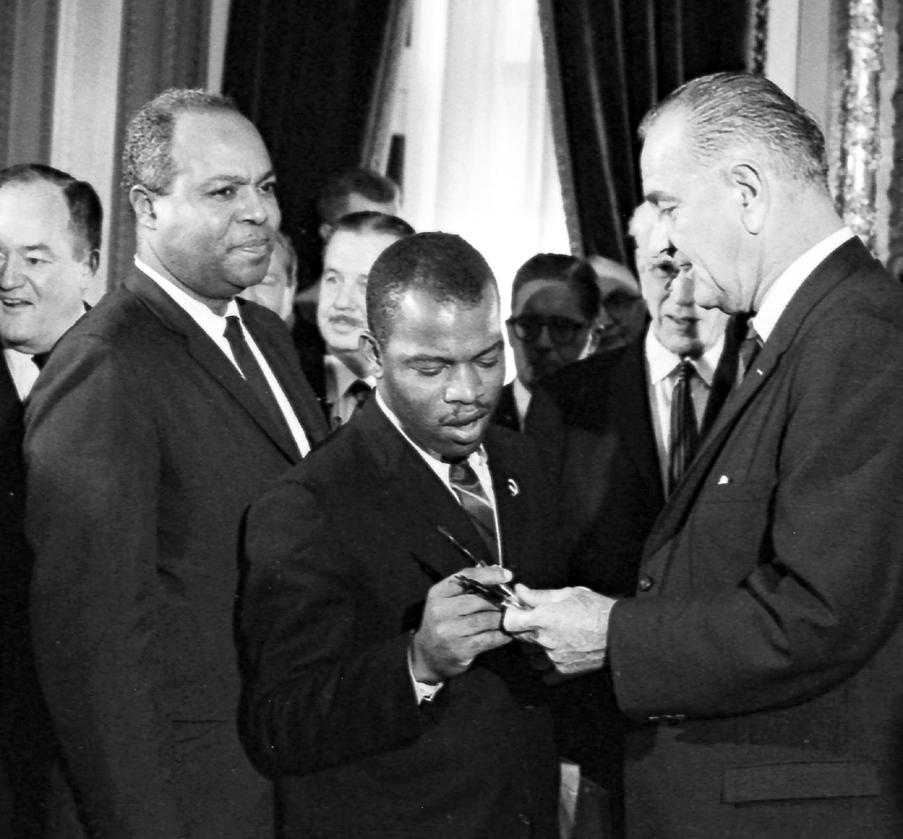


These disenfranchised citizens live in a nation with yearly elections, and yet they are barred from casting a ballot and electing candidates of their choice. Barring citizens who have served their time isn’t about making communities safer, nor is it about forcing persons who have made
mistakes to atone for those misgivings. Such is part of a broader strategy to limit who can vote.
The pattern of taking steps to limit the electorate continued in the 2000s. The June 2013 Supreme Court decision in Shelby v. Holder meant that Sections 4
legislation, which has had the cumulative impact of denying and abridging the right to vote for millions.
For instance, the Brennan Center for Justice at NYU found in 2023 that after the Shelby County decision, “at least 29 states passed 94 restrictive voting laws. While a few of these have been blocked by courts or repealed, most are still in effect…” As monumental as the Voting Rights Act of 1965 was, our nation needs something more. Sixty years after its passage, we should be asking ourselves what the next iteration of pro-voting policies entails. We should be advocating for polices that offer repair for decades of harm. We should also be asking what tools are at our disposal to protect the ballot today and for future generations.
Due to circumstances, we often get stuck in a cycle of defense rather than ideating on what future generations might need. If ever there was a time to do both defense and offense, that time is now. This moment calls for creativity, coordination, and intergenerational learning.
As we mark the 60th anniversary of the VRA, we must recognize the active attacks on democracy and continued voter suppression tactics — felony disenfranchisement, gerrymandering, limited polling place resources in predominantly Black communities, polling place closures, reductions in early voting, and Sunday voting, etc. When you add to this combination of coordinated voter suppression tactics, the active resistance to the John Lewis Voting Rights Bill, the fragility of our voting rights and democracy is ever-clear.
Laws designed to silence dissent have spread fear and anxiety, even as our nation has historically built upon responding to injustice through protests. That doesn’t mean that all hope is lost. In fact, hope is more important now than ever. This moment calls for creativity, coordination, and intergenerational learning. Most of all, it calls for hope. If we believe that our best days are behind us, we are less likely to organize and struggle for the future. Our votes are our voice.
and 5 of the landmark legislation were no longer available for civil rights litigants to use. It also meant that states with histories of discrimination no longer had to get federal preclearance for voting rights changes. The High Court’s decision opened the floodgates in terms of restrictive voting
Sixty years after its passage, the Voting Rights Act of 1965 is both bedrock and a target requiring vigilance and renewed commitment to defending and ensuring voting rights for all Americans. Today, we uplift and venerate the legacy of all of the courageous people who marched from Selma to Montgomery and remind ourselves that democracy belongs to every citizen, regardless of race, ethnicity, sexual orientation, background, or zip code. We must be prudent enough to remember that democracy requires voice, and our votes are our voice. Therefore, a threat to voting rights anywhere is a threat to voters everywhere.
Dr. Marcus Anthony Hunter is the Scott Waugh Endowed Chair in the Division of the Social Sciences, and Professor in the Departments of Sociology & African American Studies.
by Rev. Dr. Heber Brown
When one of my best friends (who is also a pastor) encouraged me to look into utilizing Artificial Intelligence (AI) tools for ministry purposes, I was exhilarated. It seemed like a game-changer at my fingertips. I used it to make presentations and outline Bible studies, saving time on the tasks that often fill my days. The opportunities seemed endless, and the convenience was remarkable. Regular projects and tasks that I had poured effort into before could now be completed in mere seconds. Not only did I start utilizing it, but I started singing its praises as well to all who would listen.
Then, earlier this summer, I was invited to teach a class entitled “The Integration of Land, Food and Faith Formation in Ministry” at Memphis Theological Seminary. In an effort to utilize the city of Memphis as part of learning opportunities for my class, I began studying the local environmental justice scene. It was then that I learned things about AI that shifted my perspective and put a damper on my enthusiasm. While teaching my class, I learned that what is touted as the largest supercomputer in the world resides in Memphis. This massive facility was established by Elon Musk to support his artificial intelligence company called xAI. Its gas turbines are releasing so much pollution that residents are saying that they can barely breathe.
Musk’s supercomputer facility is near a community called Boxtown, a neighborhood in South Memphis where over 90% of the residents are African American. Boxtown was established in 1863 by formerly enslaved Black families shortly after the signing of the Emancipation Proclamation. It has long been a site of political and economic neglect as well as a desired location for environmentally harmful corporations.
Now, Boxtown is an immediate neighbor of Elon Musk’s supercomputer facility, which is located just three miles away. Residents of Boxtown are alleging that xAI is polluting the air, the water, and affecting the physical health of people in
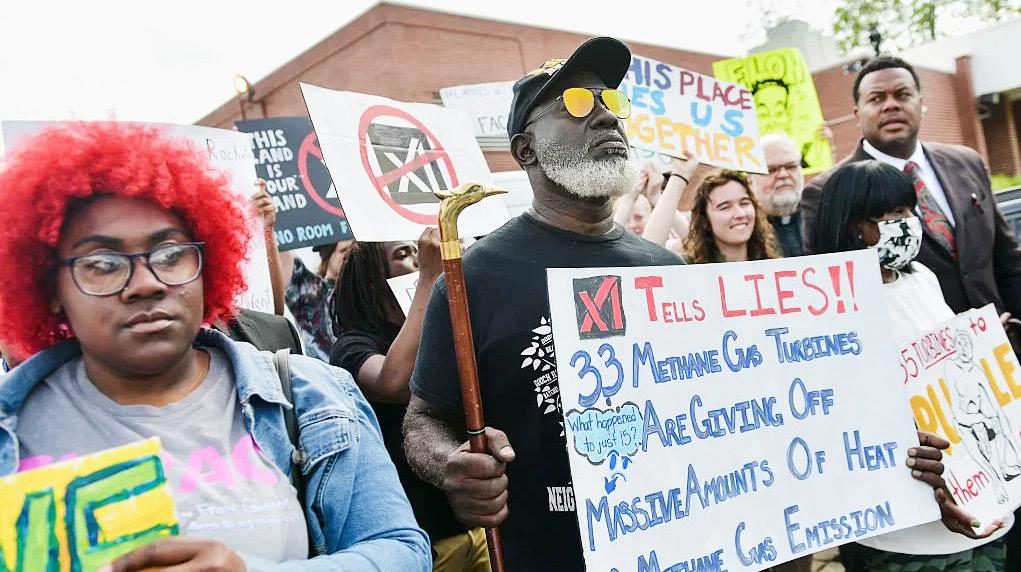
their community.
This xAI facility is filling the surrounding area — including Boxtown — with smog and harmful chemicals. Its gas turbines are releasing so much pollution that residents are saying that they can barely breathe. It has added significantly to the pollution produced by the 17 or some-odd industrial facilities in the same block of real estate.
Black communities are among those being disproportionately affected.
The more I pulled back the curtain, the more I saw the ethical and environmental issues lurking behind artificial intelligence (AI). From Musk’s supercomputers to Mark Zuckerberg’s massive data centers (co-founder of Facebook), and the countless AI facilities being quickly built by billionaires in communities around the country.
Each and every search on an AI platform expends enormous amounts of en-
ergy. Each task that we complete on these platforms pumps pollution into the air we breathe, the water we drink, and the soil we eat from. Artificial Intelligence, as currently engineered, is an environmental disaster and a threat to all who live, work, worship, or play near its facilities.
RELATED: Looks Like the EPA’s Fine With Black Folks Breathing Dirtier Air As the founder of The Black Church Food Security Network, I focus primarily on organizing African American congregations to grow food on their land and develop mutually beneficial partnerships with Black farmers in an effort to cultivate the development of Black-owned food ecosystems across the country. However, I do not have the luxury of separating issues here. Environmental racism, such as what is occurring in Boxtown, is inherently connected to the health, food justice needs, and overall well-being of Black communities.
AI supercomputers negatively impact the environment, agriculture, and food.

Black communities are among those being disproportionately affected. Residents of Boxtown are being hit with increased rates of asthma and heart disease, and a cancer risk more than four times the national average.
It is no coincidence that xAI, or any of the other industrial facilities, chose to develop in this neighborhood. The decision to develop in Memphis, in Boxtown, is the result of a long legacy of environmental racism. Black communities have been victimized over and over again in the name of science, development, and job creation.
This is not just about Boxtown or Memphis. It’s about Black communities everywhere.
Black people have a right to health. We have a right to breathe clean air. We have a right to leave our homes without fear of pollutants entering our bodies at disproportionate levels.
I am clear. Increasing our capacity to grow our own food and establish our own food ecosystems is necessary to satisfy our basic needs and decrease our dependence on corporations and the government to feed us. However, African Americans must not stop there. Food sovereignty and nutrition must work hand-in-hand with the proper stewardship of the natural environment; one without the other will continue to create lingering problems.
Protecting the profits of the richest white men in the world will never be worth more than a single human life, let alone entire Black communities.
Since my time in Memphis, I have pulled back from AI. My ability to perform any of the tasks I once delegated to AI has not diminished. AI may work faster, but becoming knowledgeable of its harms to my people put a stop to the excitement for me. Until this technology and the industries surrounding it are better informed by ethics, concern for the poor, and racial and environmental justice, I will not be able to, in good conscience, promote it or participate uncritically on its platforms.
While it may be impossible to stop this new technology in its tracks altogether, our use of AI must be selective and measured. We must reasonably weigh its values against its harms. We cannot compromise our ethics in the name of “convenience” or rushing to get a seat at the table as the industry takes off.
The “convenience” that AI provides will never be worth the havoc it wreaks on the environment and our health. Protecting the profits of the richest white men in the world will never be worth more than a single human life, let alone entire Black communities. I will do my level best to use technology responsibly, ethically, and undergirded by my allegiance to the God of my understanding who wishes above all that we prosper and be in health, even as our souls prosper.
Rev. Dr. Heber Brown, III is an author, pastor, and founder of The Black Church Food Security Network.

The event will take place August 8, in Edgartown, Mass.
In May, Aramis announced a new fragrance, Intuition by Aramis, and stated that former Miami Heat basketball legend Dwyane Wade will be the global ambassador. On Aug. 8, at Martha’s Vineyard during the African American Film Festival, he will be on hand to take part in a fireside conversation with the brand.
Intuition by Aramis has launched this month, and to celebrate its debut, it will present a series of curated events, including a pop-up experience, a VIP dinner, and an insightful panel discussion featuring Wade.
“I’m excited to join the Aramis family as a Global Ambassador and launch Intuition by Aramis this summer,” said Wade in a written statement. “Aramis is a brand

that aligns with my values, and Intuition reflects modern masculinity and confidence. Fragrance is all about how you present yourself to the world. Your scent is part of your vibe, and my new fragrance truly levels up your scent game.”
Aramis is the sponsor of the annual C-Suite Men’s Luncheon at the Martha’s Vineyard African American Film Festival, where leaders of various industries within the Black community will gather to network. The program will be anchored by an intimate, unfiltered fireside conversation with Wade, followed by Intuition by Aramis‘ first-ever Pop-Up Sampling Experience at Pelican Bay.
The luncheon takes place at The Harbor View Hotel in Edgartown, Massachusetts, on Aug. 6, with the Intuition by Armis Pop-Up happening Aug. 6 and Aug. 7
at The Pelican Club. The pop-up will be open to the public, offering a playful, immersive, and interactive journey into the world of Intuition by Aramis.
“We couldn’t be more excited to be announcing Intuition by Aramis with the incomparable Dwyane Wade,” said Justin Boxford, Global Brand President, Estée Lauder & Aramis. “From family to fashion to philanthropy, Dwyane is a visionary and a changemaker who is the epitome of modern masculinity. Through the reimagination of Aramis and the collaboration with Dwyane, we are able to honor the brand’s incredible heritage while tapping into new consumers in the rapidly growing men’s fragrance market.” Intuition by Aramis is available at key global retailers and will retail for $95/50ml and $130/100ml.
The tech conglomerate dropped groups with mission statements including words such as “diversity, “equity,” “inclusion,” or “race,” “activism,” and “women.”
Google is keeping the anti-diversity, equity, and inclusion narrative alive by removing more than 50 DEI-focused groups from its list of organizations that the company provides funding to, CNBC reports.
A new report from tech watchdog organization The Tech Transparency Project reveals Google removed a total of 214 groups from the funding list, with 58 related to DEI. By bowing down to President Donald Trump’s anti-diversity executive order, the tech conglomerate dropped groups with mission statements including words such as “diversity, “equity,” “inclusion,” “race,” “activism,” and “women.”
Some organizations dropped from the list include the African American Community Service Agency, whose goal is to “empower all Black and historically excluded communities,” the Latino Leadership Alliance, dedicated to “race equity affecting the Latino community,” and Enroot, which curates out-of-school experiences for immigrant kids.
Another group purged from the list was the National Network to End Domestic Violence, providing training, assistance, and public awareness campaigns for vi-

olence against women. Having remained on Google’s funder organization list for nine years, the company claims it still donated $75,000 to the group in 2024, but never explained why it was removed from the list.
Google spokesperson José Castañeda claims the list reflects companies with
contributions in 2024 — not contributions made by other teams within Google. “We contribute to hundreds of groups from across the political spectrum that advocate for pro-innovation policies, and those groups change from year to year based on where our contributions will have the most impact,” he said in a statement.
The company has given mixed signals about its stance on diversity efforts.
While Google’s CEO, Sundar Pichai, labeled the company’s views on diversity as necessary in the workplace during an all-hands meeting in March 2025, after Trump’s executive order, Google’s Chief People Officer, Fiona Cicconi, told a dif-
ferent story.
Cicconi alerted employees that the company would end its DEI-related hiring “aspirational goals” due to federal requirements and Google’s classification as a federal contractor. Google stood behind the announcement by removing language referring to “underrepresented” groups from the grant website.
“We’re a global company, we have users around the world, and we think the best way to serve them well is by having a workforce that represents that diversity,” the CEO, who attended Trump’s inauguration, said at the time.
According to TechCrunch, the tech company also removed mentions of “diversity” and “equity” from its responsible AI webpage and any mention of DEI from its 2025 10-K filings.
While Silicon Valley and other industries have stood beside DEI programs to rid bias in hiring and curate fair practices in the workplace, diversity advocates have pointed the blame not only at the Trump administration for its anti-DEI switch up but the Supreme Court as well, who in 2023 decided to end affirmative action in college admission processes following threats from conservative groups.















Ellison Sues Trump Admin to Stop Planned Parenthood Medicaid Cuts Minnesota Attorney General Keith Ellison is taking the Trump administration to court over a budget provision that could block Medicaid reimbursements to Planned Parenthood, threatening critical health services for thousands across Minnesota. native clinics could handle the overflow is unfounded.
Minnesota Attorney General Keith Ellison has joined a 23-state coalition in filing a lawsuit against the Trump administration, challenging a controversial budget provision that would block Medicaid reimbursements to Planned Parenthood health centers nationwide.
Stay in the know. Sign up for our newsletter!
Get your daily dose of community news, info, events, exclusive deals and more! At stake is over $9 million in annual Medicaid funding that Planned Parenthood relies on in Minnesota alone—money that helps provide more than 30,000 patient visits every year for cancer screenings, STI testing, family planning, and other essential care.
“Planned Parenthood is an essential healthcare provider that so many Minnesotans rely on,” said Ellison. “Make no mistake, the Trump administration’s attempts to defund Planned Parenthood will hurt the people of Minnesota, especially women, the LGBTQ+ community, and

Minnesota Attorney General Keith Ellison speaks during a press conference at the Minnesota State Capitol in St. Paul, Minn. on Tuesday, March 4, 2025. The Minnesota Department of Human Rights, represented by Minnesota Attorney General Keith Ellison, today filed to join a lawsuit against Absolute Drywall for violating the Minnesota Human Rights Act by allowing an employee to sexually harass and rape another employee, Norma Izaguirre, and then firing her after she reported the harassment. ] LEILA NAVIDI • leila.navidi@startribune.com
low-income folks. I’m taking the Trump administration to court to prevent these harmful cuts and defend the well-being of Minnesotans everywhere.”
The lawsuit, filed by attorneys general from 22 states and the District of Columbia, argues that the so-called “Defund Provision” in the federal budget reconciliation bill is unconstitutional. The coalition claims the measure is vague, punitive, and would result in greater health risks and costs for their states.
A recent federal court ruling in Boston already granted a preliminary injunction in a related case brought by Planned Parenthood, finding the Defund Provision likely violates both the First Amendment and the Equal Protection Clause.
Local Impact
In Minnesota, Medicaid supports health care for 1.2 million residents, with Planned Parenthood playing a critical role in delivering care that many other providers can’t absorb. According to the Guttmacher Institute, the claim that alter-
Ellison’s office estimates that if the provision takes effect, it could cost Minnesota an additional $30 million in Medicaid expenses over the next five years—and $52 million over ten.
National Scope
The lawsuit has drawn support from the attorneys general of California, Illinois, Michigan, New York, Washington, and others, as well as Pennsylvania Gov. Josh Shapiro in his official capacity.
“This is about health care access, equity, and the constitutional rights of our residents,” said the coalition in a joint statement. “We’re urging the court to enjoin the administration from implementing this reckless and harmful provision.”
The case is expected to play out in the coming months with major implications for reproductive health access nationwide, especially for low-income communities, women, and LGBTQ+ individuals who rely on Medicaid to cover care.
by Kofi Oppong Kyekyeku, Face2FaceAfrica.com
In a move that could dramatically reshape access to U.S. travel for many, the State Department is proposing a controversial bond requirement of up to $15,000 for business and tourist visa applicants from certain countries.
The measure, set to be detailed in Tuesday’s Federal Register, outlines a 12-month pilot program targeting nationals from countries flagged for high visa overstay rates, weak internal document controls, or those offering citizenship without residency obligations. Under the program, selected applicants may be required to pay bonds of $5,000, $10,000, or $15,000.
“Aliens applying for visas as temporary visitors for business or pleasure and who are nationals of countries identified by the department as having high visa
overstay rates, where screening and vetting information is deemed deficient, or offering citizenship by investment, if the alien obtained citizenship with no residency requirement, may be subject to the pilot program,” the official notice stated. While the exact list of affected countries will be released once the rule is implemented, the department says the bond may be waived depending on an applicant’s individual circumstances.
The pilot program is expected to take effect within 15 days of its publication, AP reported. Officials argue the initiative is designed to protect the U.S. government from potential costs if a visitor overstays or violates their visa terms.
A preview of the notice, posted online Monday, underscores the administration’s broader immigration overhaul. Just last week, the State Department announced that more visa renewal applicants would now be required to attend in-person inter-

views, an extra step not previously mandated. Additionally, the Diversity Visa Lottery applicants must now possess valid passports from their home countries. The proposal will not affect citizens from countries participating in the Visa Waiver Program, which permits short-term travel to the U.S. without a visa for up to 90 days. Most of the 42 nations in this program are in Europe, with others in the Middle East and Asia.
Although visa bond ideas have surfaced in prior administrations, they’ve never advanced this far. Historically, the State Department discouraged such measures due to their bureaucratic complexity and concerns they might foster public misconceptions. But now, the agency asserts that this previous stance lacked a factual basis. “That view is not supported by any recent examples or evidence, as visa bonds have not generally been required in any recent period,” the department argued.

by Jeanette W. Weldon, CHEFA
This year, the Connecticut Health and Educational Facilities Authority (CHEFA) celebrates a milestone — 60 years of helping Connecticut’s nonprofits grow stronger so they can better serve
Connecticut residents. But what does six decades of impact look like in today’s terms?
According to a new economic impact study by IHS Markit, from 2019 through 2024, CHEFA facilitated more than $2.06 billion in tax-exempt financing for capital projects at Connecticut’s nonprofit healthcare and educational institutions. These projects generated an average annual impact of $900 million to the state’s gross domestic product and supported an average of 9,486 jobs each year, over half of which were in the construction sector.
However, CHEFA’s impact goes beyond the numbers — it’s seen in the construction teams bringing Yale New Haven Health’s Neuroscience Tower to life, the educators and researchers shaping the future at Sacred Heart University’s expanded Health & Science Center, and the families who now have greater access to high-quality care at Connecticut Children’s Medical Center.
These projects not only create jobs but also foster long-term economic resilience. CHEFA-financed facilities attract talent, drive research and innovation, and offer essential services that uplift
entire communities.
Notably, these economic benefits are realized without placing a burden on Connecticut taxpayers. As a self-sustaining organization, CHEFA enables institutions to pursue essential improvements in healthcare, education, and community services. By offering access to affordable financing, CHEFA helps mission-driven organizations act when it matters most by supporting long-term investments that strengthen Connecticut’s future, even in times of economic uncertainty.
As we reflect on CHEFA’s 60 years
of service, we do so with pride in what we’ve helped make possible — and with a deep sense of responsibility for what lies ahead. Connecticut’s needs are evolving, and so is CHEFA. Whether it’s helping fund pediatric hospitals, student housing, or mental health facilities, CHEFA’s mission remains clear: to advance a healthier, more educated, more resilient Connecticut.
The numbers tell one story. But the real impact of CHEFA is measured in stronger communities, greater opportunity, and a better future for all.

